#and free guided tours of the city if you have a layover 12 hours or longer
Explore tagged Tumblr posts
Text
my flight to Australia includes a 17 hour layover in Shanghai and I'm literally so excited about it my heart starts racing every time I think about it likeeeee I'm kinda scared but what a fucking ADVENTURE it's gonna be
#for those who don't know this is the biggest airport in the world#there's like. multiple swimming pools and a ZOO in it#food street vendors but in the airport etc#and free guided tours of the city if you have a layover 12 hours or longer#you can rent a bike and bike into the city#like super insanely easy and super insanely safe no matter what you do#they market it like a day trip to an amusement park but I get to like. microdose an entire new country?????#like an entire new genre of country and experiences and culture and language I've never even IMAGINED#like I can't wait I can't wait I can't WAIT
27 notes
·
View notes
Text
Your Ultimate Guide for Traveling from Dhaka to the UK

Embarking on a journey from Dhaka to the UK is an exciting adventure filled with historical landmarks, diverse cultures, and countless attractions. This guide will help you navigate every aspect of your trip, from visas to must-see destinations.
Visa Requirements
Types of Visas Travelers from Bangladesh need a visa to enter the UK. Common options include the Standard Visitor Visa and the Short-term Study Visa.
Application Process: Complete your application online via the UK government website.
Documents Needed: Passport, financial statements, travel itinerary, and possibly a letter of invitation.
Processing Time: Generally around 3 weeks, so plan ahead.
Best Time to Visit
Seasons and Weather
Spring (March-May): Mild and pleasant, perfect for sightseeing.
Summer (June-August): Warm with many festivals and outdoor events.
Autumn (September-November): Cooler temperatures and beautiful autumn leaves.
Winter (December-February): Cold, with festive Christmas markets and potential snow.
Flights and Transportation
Booking Your Flight Several airlines offer flights from Dhaka to UK cities like London and Manchester. Popular choices include British Airways, Emirates, and Qatar Airways. The flight typically takes around 12-14 hours including layovers.
Tips for Booking: Book early and use comparison sites to find the best deals.
Getting Around the UK
Trains: Efficient and fast for travel between major cities.
Buses and Coaches: Affordable options with extensive networks.
Car Rentals: Ideal for exploring rural areas and having more travel flexibility.
Top Attractions
Must-See Places
London: Big Ben, the British Museum, Buckingham Palace.
Edinburgh: Edinburgh Castle, Arthur’s Seat, Royal Mile.
Manchester: Science and Industry Museum, Manchester Cathedral.
Liverpool: The Beatles Story, Albert Dock, Liverpool Cathedral.
Cultural Experiences
Rich Heritage
Historical Sites: Stonehenge, Bath, and Tower of London are must-visit UNESCO sites.
Museums: Many are free, including the British Museum and the National Gallery.
Theatre and Music: Catch a West End show in London or enjoy music festivals like Glastonbury.
Dining and Culinary Experiences
Food to Try
Traditional: Fish and chips, Sunday roasts, and Cornish pasties.
Afternoon Tea: A quintessential British experience with scones, sandwiches, and tea.
Fine Dining: Michelin-starred restaurants like The Fat Duck offer world-class dining.
Shopping and Entertainment
Where to Shop
London: Oxford Street, Regent Street, Harrods.
Edinburgh: Princes Street for high-end shops and boutiques.
Outlet Malls: Bicester Village for designer deals.
Entertainment Options
Theatre: West End productions in London.
Sports: Premier League matches, Wimbledon, British Grand Prix.
Festivals: Notting Hill Carnival, Edinburgh Fringe Festival.
Travel Agencies and Tour Operators
Top Agencies
Roomchai Limited: Known for tailored travel packages and exceptional service.
Gozayaan: Comprehensive travel solutions with great customer service.
Obokash: Travel arrangements and visa assistance.
Sharetrip: Variety of travel packages and flight bookings.
FlyHub: Competitive pricing and extensive services.
Travelzoo Bangladesh: Deals on flights, hotels, and tour packages.
Travel Tips and Safety Precautions
Staying Safe
Laws and Customs: Respect local laws and cultural norms.
Health and Safety: Keep emergency contacts handy, and stay aware of your surroundings.
Transport Safety: Use reputable services and stay vigilant in crowded areas.
Conclusion
A trip from Dhaka to the UK offers an enriching blend of history, culture, and modern attractions. With careful planning and the support of reliable travel agencies like Roomchai Limited and Gozayaan, your journey will be seamless and memorable. From exploring London’s iconic landmarks to discovering Scotland’s natural beauty, the UK is a destination that promises a unique and unforgettable travel experience.
#DhakatoUK#TravelGuide#UKTravel#RoomchaiLimited#Gozayaan#VisaProcess#FlightBooking#TopAttractions#CulturalHeritage#TravelTips#TravelAgencies#LondonTravel#EdinburghTravel
0 notes
Text
The 13 Best Things to See and Do in Taipei

Posted: 5/30/2020 | May 30th, 2020
Taipei, the capital of Taiwan and its most populous city, is the epicenter of tourism for the country (though most people just come for a short layover as it’s a major air hub for Asia).
And while there is plenty to do elsewhere in Taiwan, even if you don’t leave Taipei, you can still find lots of things to see and do in the area to fill close to a week!
I love Taipei. I lived here in 2010 while I taught English and built this website. It was a wonderful experience that helped me grow as a person. A decade later, I finally made it back to the city I loved so much and it was remarkable to see that so much of what I loved was still there: the endless gigantic food markets serving some of the best food in the world, a wild nightlife, spacious parks, interesting and quirky museums, and nearby mountains that call to you with easy and accessible hikes.
Taipei (like Taiwan as a whole) is a hugely underrated destination and I can’t urge you enough to visit. It combines culture, nature, wonderful people, and affordability. I don’t understand why more people don’t visit but make their loss, your gain!
To help you plan your trip, here are my top 13 things to do while in Taipei:
1. Take a Free Walking Tour
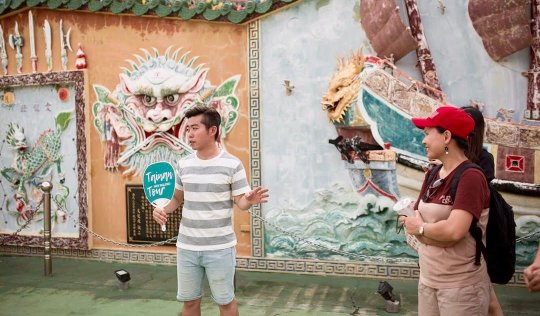
One of the first things I do when I arrive in a new destination is to take a free walking tour. They show you the lay of the land and help you see a place’s highlights while learning a little about its history and culture. Plus, you get access to a local who can answer any and all of your questions.
Like It Formosa offers free daily walking tours around Taipei. Their tours focus more on cultural history than their competitor, Tour Me Away, which also offers free walking tours geared towards the backpacker crowd (Tour Me Away also runs pub crawls).
2. Visit the National Palace Museum

The National Palace Museum has over 70,000 artifacts from Imperial China, most of which were brought to Taiwan during the Chinese Civil War (1929–1947). In addition to the permanent exhibits, there are also rotating exhibits throughout the year as well as a section for children. There are free daily tours in English too. If you can’t get on the tour, get the audio guide. While the descriptions on the artifacts are pretty detailed, the audio tour goes into even more depth and gives you deeper insight into what you are seeing and the time period it is from.
221, Sec 2, Zhi Shan Road, +886 2 2881 2021, npm.gov.tw. Open Sunday–Thursday 8:30am–6:30pm and Friday–Saturday 8:30am–9pm. Admission is 350 NT$ ($11.65 USD) (470 NT$ ($15.65 USD) with an audio guide).
3. Soak in the Hot Springs
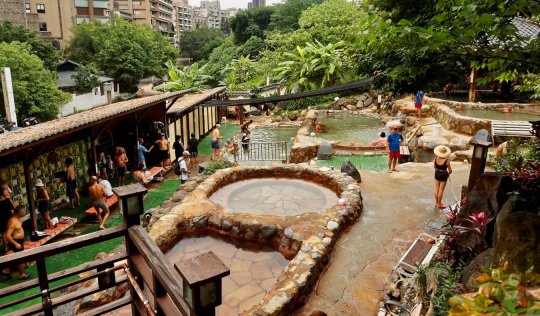
The Beitou Hot Springs area is a popular destination since it’s on the MRT (metro system) and only 30 minutes from downtown. There are lots of resorts, spas, and inns in the area where you can enjoy a dip in a hot spring. Be sure to also visit the Hot Springs Museum (housed in an old bathhouse from 1913), the Xinbeitou Historic Station (a heritage train station from 1916), and Thermal Valley (a sulfurous lake nearby that has walking trails).
Admission to most hot springs starts around 40 NT$ ($1.33 USD) per person, making it a very affordable getaway for anyone looking for some R&R.
Hot Springs Museum: No. 2, Zhongshan Road, +886 2 2893 9981, hotspringmuseum.taipei. Open daily from 9am-5pm. Admission is free.
Xinbeitou Historic Station: 1 Qixing St., +886 2 2891 5558, xbths.taipei. Open Tuesday-Thursday from 10am-6pm and Friday-Sunday from 10am-8:30pm (closed Mondays). Admission is free.
4. Take a Cooking Class

Taiwan is a foodie’s dream! You got noodle soups, incredible rice dishes, amazing buns, dumplings, scallion pancakes, and so much more. The food in the country is world-class. While cooking classes here are a little pricey, they do take you through the local markets and teach you about local ingredients and how to make some traditional dishes. I always found Taiwanese food intimidating so it was nice to have someone help me understand the local food. It made me more adventurous in the night markets.
Some cooking classes worth checking out are:
Ivy’s Kitchen
CookInn Taiwan
Make My Day Cooking Lab
Expect to pay around 2,000 NT$ ($67 USD) for a class.
5. Visit the Museums

Taipei has a lot of museums. Given its size, I was surprised by how many actually they had, especially since the city isn’t known as being a center for museums. Here are some of my favorites:
National Taiwan Museum – This is the oldest museum in Taiwan and covers its history from a variety of different scientific perspectives, such as anthropology, earth sciences, zoology, and botany. It’s really basic and best if you go with kids. Admission is 30 NT$ ($1 USD).
Miniatures Museum of Taipei – Opened in 1997, this museum is home to over 200 architectural miniatures, including castles, replica towns and streets, and even a 1/12 scale model of Buckingham Palace. It’s a weird museum but pretty cool. Admission is 180 NT$ ($6 USD).
Museum of Contemporary Arts – I’m not a fan of contemporary art myself, but if you are, then don’t miss this museum. It has a rotating collection of exhibits, so there is always something new on display. Admission is 50 NT$ ($1.66 USD).
Taipei Astronomical Museum – A fun and educational museum with exhibitions on ancient astronomy, technology, telescopes, the solar system, and much more. Admission is 60 NT$ ($2 USD).
Taipei Fine Art Museum – Opened in 1983, this was the first art museum in Taiwan. It’s home to a wide variety of works from both international and Taiwanese artists and hosts rotating exhibitions too. Admission is 30 NT$ ($1 USD).
National 228 Memorial Museum – This museum is dedicated to the tragic events that began on February 28, 1947, when an uprising against the Chinese government started following World War II. Admission is 20 NT$ ($0.67 USD).
6. Go Hiking

Taipei has plenty of hiking trails just outside town that are easily accessible. There are easy, moderate, and challenging trails, as well as both short and full-day hikes. Here are a few worth checking out:
Xiangshan Trail – An easy 45-minute hike that offers nice views of Taipei. It’s just a 10-minute walk from the Xiangshan MRT station.
Bitoujiao Trail – Located one hour from town by car, this moderate hike takes you along the coast. The trail is in the Ruifeng District 11km east of Jiufen. The hike takes 2-3 hours.
Jinmianshan Trail – An easy 1.5-hour hike in Yangmingshan National Park. The trail starts a 10-minute walk from the Xihu MRT station.
Huang Didian Trail – A challenging ridge hike that takes around five hours. From Muzha Station, board the bus to Huafan University and get off at Huangdi Temple. From there, the trail is 25 minutes away on foot.
Pingxi Crag Trail – A moderate 2-3-hour hike with lots of steep sections. For experienced hikers only. The trail begins just five minutes away from Pingxi station.
7. Take a Day Trip to Jiufen

Jiufen is one of Taiwan’s most popular tourist destinations. First, because it’s incorrectly believed to be the origin of the film Spirited Away, so people come for that. Second, it’s famous for being a historic gold-mining town with it’s preserved old streets. And, third, it’s famous for its traditional teahouses.
Jiufen is tiny. You can walk around in about 30 minutes. The center of the city and its historic streets and buildings are all preserved as they looked 100 years ago so walking around here is a cool experience. Be sure to come early (like first thing in the morning) to beat the crowds because, by midday, the streets are wall-to-wall people. If you stay the night, you’ll also get the city to yourself once the crowds leave around 4pm.
As a tea lover, this is one of my favorite places in Taiwan because it’s home to some beautiful teahouses in the most stunning settings. It also overlooks a bay in the distance, and there are lots of lookouts.
Some teahouses not to miss are:
Siidcha Tea House
Skyline Tea House
Amei Tea House
Taro of Sweet
Jiufen Tea House
Additionally, there are a few museums highlighting the town’s gold mining past, lots of parks and lookouts, and some nearby hiking trails. (If you want to hike, spend the night as you’ll need the extra time.) Like It Formosa does a free walking tour here too (for this one, you need to sign up in advance because they only do it when people register).
The trip will take around 1-1.5 hours by train and bus. Take the train from Songshan Station (in Taipei) to Ruifang Station. From there you can take a bus straight to Jiufen. Expect to spend around 100 NT$ ($3.33 USD) for your round-trip ticket. There are also tourist buses with organized day trips; these usually cost around 475 NT$ ($16 USD).
8. See the Temples

Taipei brilliantly mixes the old and the new. Almost 90% of Taiwan identifies as either Buddhist or Taoist, and that is reflected in Taipei’s temples. Here are some of the most popular and ornate temples:
Longshan Temple – Built in 1738, this temple was built to honor the goddess of mercy, Guanyin. There are also statues worshipping 100 other Chinese folk deities here as well. The temple has been damaged or destroyed numerous times by earthquakes or military conflicts, but it is always rebuilt by the locals who still visit and worship at it. No. 211, Guangzhou Street, Wanhua District.
Bao-an Temple – Dalongdong Baoan Temple (Bao-an for short) is a Taiwanese folk religion temple and a UNESCO World Heritage Site. It dates to the mid-18th century and is home to two dragon columns that are over two centuries old. It looks particularly amazing lit up at night. No. 61, Hami Street, Datong District.
Confucius Temple – Located near the Bao-an temple, this simple temple is dedicated to the famous philosopher Confucius, whose teachings are part of the cultural backbone of both Taiwan and mainland China. It’s modeled after the original Confucius Temple in Qufu, the hometown of Confucius in mainland China. No. 275, Dalong Street, Datong District.
9. Enjoy the View from Taipei 101
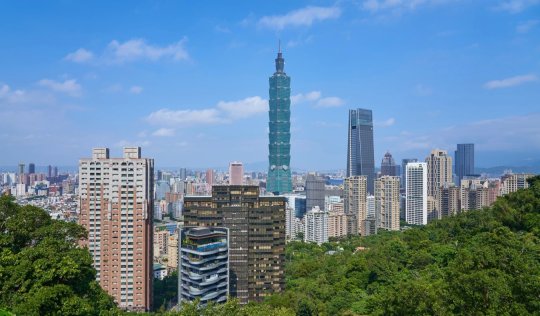
For the best views in Taipei, visit Taipei 101. Opened in 2004, this was the tallest building in the world until 2010 (when the Burj Khalifa took its place). Standing 508m (1,667 feet) tall, it towers over Taipei.
Even though I hate heights, you can’t visit Taipei without seeing it from the top of this building. There is an observation platform on the 89th floor that is absolutely breathtaking. You can also go up to the 91st floor and step outside if you want to really get your blood pumping (don’t worry, there are bars so you can’t fall).
Additionally, go to Morton’s Steakhouse for happy hour. Not only do they have super cheap drink specials but their patio provides some extraordinary views of Taipei 101 itself.
No. 7, Section 5, Xinyi Road, taipei-101.com.tw/en/observatory. Open daily 11am–9pm. Admission is 600 NT$ ($20 USD).
10. See the Chiang Kai-shek Memorial Hall

Officially known as Liberty Square, this national monument was built in 1976 in honor of Chiang Kai-shek, former president of the Republic of China. He ruled mainland China from 1928 to 1949, and then in Taiwan from 1949 until his death in 1975.
In addition to his monument, which is over 75m (250 feet) tall, there is also a massive open square where rallies and protests have been held over the years (hence its renaming as Liberty Square). The memorial also houses a library and a museum that documents Chiang Kai-shek’s life and career. It also has exhibits on Taiwan’s history and how the country evolved throughout the years.
No. 21, Zhongshan South Road, Zhongzheng District, +886-2-2343-1100, cksmh.gov.tw. Open daily from 9am-6pm. Admission is free.
11. Ride the Maokong Gondola

Take a ride on the Maokong Gondola, which was built in 2007, and get some great views of the city and surrounding forests. The route stretches over 4km (2.5 miles) and includes several stations between the Taipei Zoo and Maokong.
Spend some time exploring Maokong as it was once the prime tea-growing area of Taiwan. There are lots of winding footpaths you can wander, teahouses and cafes (the area still produces a lot of tea), and stunning views of Taipei (especially at night when the city is all lit up). It’s a popular spot on the weekend so visit during the week to avoid the crowds.
Stations at Taipei Zoo (2), Zhinan Temple, and Maokong. Open Monday–Friday 9am–9pm (10pm on Fridays), Saturdays 8:30am–10pm, and Sundays 8:30am–9pm. Tickets start at 70 NT$ ($2.33 USD).
12. Explore the Night Markets

Taipei is home to dozens of night markets — and most of them have tons of delicious food stalls. Here are a few worth checking out:
Shulin Night Market – This is the biggest night market in Taiwan. Opened in 2017, it is home to over 400 vendors and covers a massive 12 acres. It’s full of delicious (and cheap) street food, as well as clothing, electronics, and all sorts of souvenirs and other goods.
Raohe Night Market – The second most popular night market. Be sure to try the black pepper buns while you’re here. There’s also a Michelin-recognized food stall that you shouldn’t miss called Chen Dong Ribs Stewed in Medicinal Herbs.
Tonghua Night Market – This night market is popular with locals, as it has a ton of delicious places to eat. It’s essentially a food market more than anything else. Be sure to try the stinky tofu!
Snake Alley – Located in the former red-light district, it gets its name from the fact that many tourists used to come here to eat snake meat. While I wouldn’t recommend that, there’s a tasty Michelin-recognized stall that’s worth sampling called Hsiao Wang Steamed Minced Pork with Pickles in Broth.
Ningxia Night Market – This is one of the smaller night markets, so it’s easy to explore (though it does get crowded). There are lots of delicious oyster stalls here.
13. See the National Dr. Sun Yat-Sen Memorial Hall

Sun Yat-sen was a politician, physician, and philosopher, as well as the first president of Taiwan. This memorial was built in 1972 to honor Doctor Sun Yat-sen. He’s considered “the Father of the Nation,” and the memorial hall is home to items from his personal and professional life. He’s one of the few figures beloved in both mainland China and Taiwan, as he was instrumental in the overthrow of China’s last imperial dynasty.
In addition to the hall’s museumesque displays of Sun’s possessions, it also serves as a meeting place, educational center, and cultural center.
No. 505, Section 4, Ren’ai Road, (02) 27588008 #546, yatsen.gov.tw. Open daily 9am–6pm. Admission is free.
***
From the food to museums to natural beauty, Taipei is a world-class city that I don’t think people appreciate enough. It needs to be on people’s radar more. I loved my time living there and coming back to visit just reminded me how marvelous (and affordable) the city is!
Make visiting Taipei a priority. With so much to see and do, you’re guaranteed to have an outstanding visit.
Book Your Trip to Taipei: Logistical Tips and Tricks
Book Your Flight Find a cheap flight by using Skyscanner or Momondo. They are my two favorite search engines because they search websites and airlines around the globe so you always know no stone is left unturned.
Book Your Accommodation You can book your hostel with Hostelworld. If you want to stay elsewhere, use Booking.com as they consistently return the cheapest rates for guesthouses and cheap hotels. My favorite places to stay in Taipei are:
Star Hostel
Homey Hostel
Flip Flop Hostel
Don’t Forget Travel Insurance Travel insurance will protect you against illness, injury, theft, and cancellations. It’s comprehensive protection in case anything goes wrong. I never go on a trip without it as I’ve had to use it many times in the past. I’ve been using World Nomads for ten years. My favorite companies that offer the best service and value are:
World Nomads (for everyone below 70)
Insure My Trip (for those over 70)
Looking for the best companies to save money with? Check out my resource page for the best companies to use when you travel! I list all the ones I use to save money when I travel – and I think will help you too!
Looking for more information on visiting Taiwan? For more tips about visiting Taiwan, check out my introduction to Taiwan for more tips on what to see, do, costs, ways to save, and much, much more!
Photo credit: 1 – Heikki Holstila, 2, 3 – Caitriana Nicholson, 4 – familyfriends754, 6 – Guillaume Paumier, 14 – Ilee_wu
The post The 13 Best Things to See and Do in Taipei appeared first on Nomadic Matt's Travel Site.
from Nomadic Matt's Travel Site https://ift.tt/36UUEyl via IFTTT
0 notes
Text
Greece-y Turkey
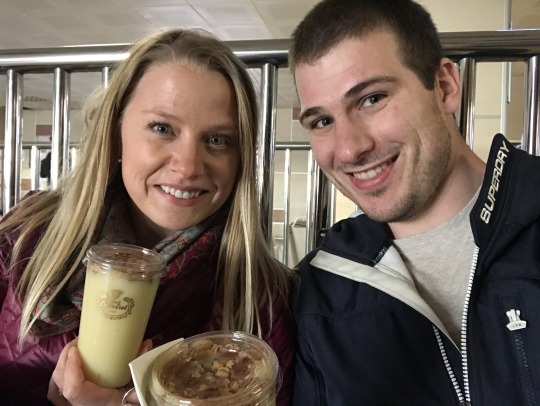
Hold onto your butts- this one is a long one. We spent a week on vacation, so we have a lot to write about.
A couple of months ago, Mariah and I were talking about plans to go on a longer trip for her birthday and for Thanksgiving, both of which would fall on the same week. We first discussed Iceland- eventually turning it down not due to the cold (it’s apparently always cold in Iceland), but due to the perpetual darkness with no guarantee for a decent view of the Northern Lights. So we looked for warmer alternatives. After talking to various friends that had been there before, our minds turned towards Turkey. Sure, the political climate hasn’t been great the past couple of years, but we figured the everyday people would be friendly enough. Besides, Turkey looked beautiful, and Istanbul is one of the most historic cities in the world. So we made plans… oh, and we decided why not go to Greece in the same trip?
The trip wasn’t without snags… Turkey requires a visa for US citizens. We bought ours online, and two days later, shit went down and the US and Turkey revoked tourist visa privileges from each other. So… we didn’t know if we could go for a few weeks. We ended up calling the embassy and previously issued travel visas were said to be honored. Further, eventually privileges were reinstated by both countries. That didn’t stop the Dutch checking agents at the airport from harassing us with outdated information- they almost didn’t let us board because, ‘Well, the presidents of both countries are fighting right now.’ Um, close… I guess. And people say Americans are ignorant.
Obviously we got on the plane. It was literally the last flight out of Schipol at midnight. A poor three and a half hours of sleep and we were in Istanbul. But that was just the layover. Another sleepless few hours and we were in Kayseri- a small city in the center of the Asian portion of the country. From there, it was an hour shuttle ride to Goreme, the main city in the Cappadocia region. Yes, I wrote this to indicate the bit of a pain to get to Cappadocia, but it is worth it. The region is populated with ‘fairy chimney’ rock formations. They are gorgeous, and even more so when you learn that people carved homes and churches in them in the middle ages. Now, whole hotels are embedded in the rocks- including ours! After settling in, Mariah and I found lunch (delicious Turkish pide), and just walked around taking in the sites. I mean, the sunset was amazing! Then was an early dinner (seriously delicious and home cooked) and early bedtime.
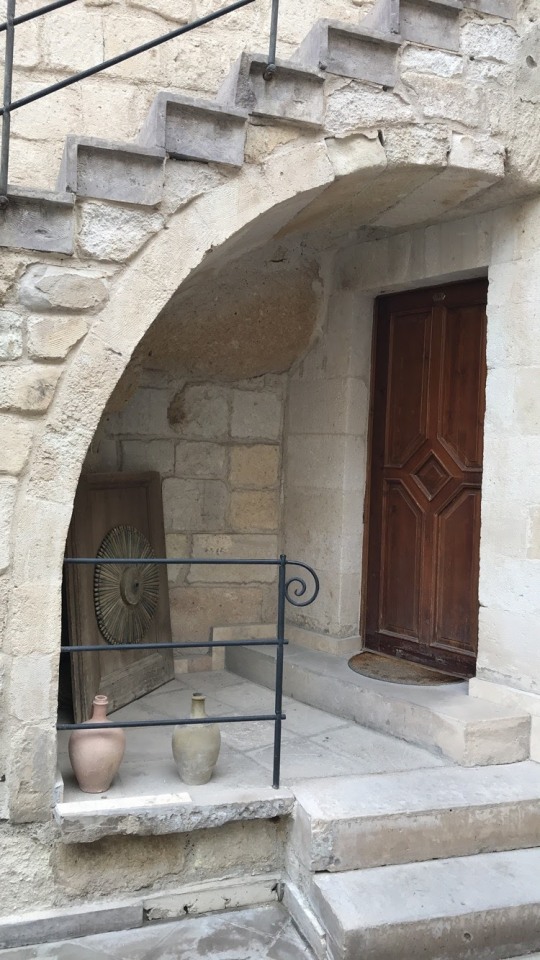
Our cave hotel
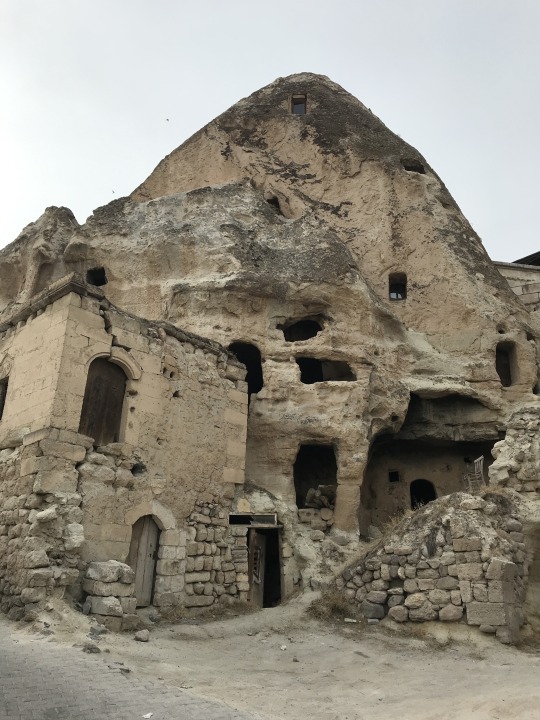
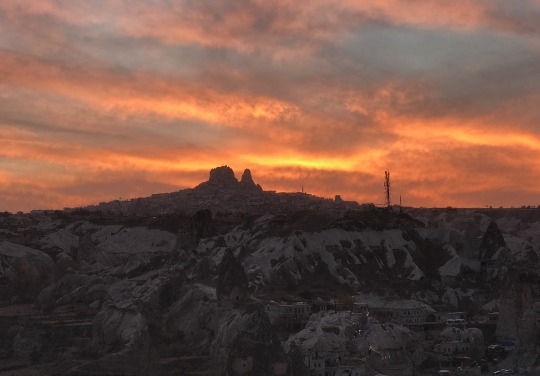

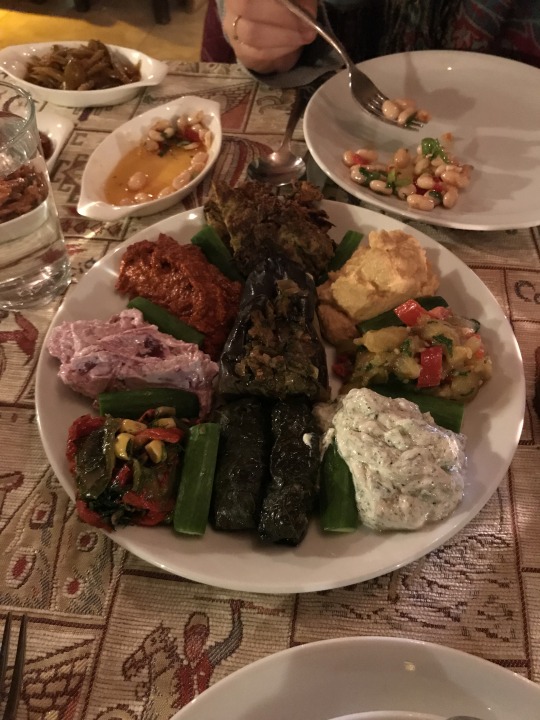
The next morning, we were supposed to have a balloon tour to see the sunrise, but the wind was too strong to go up. Oh well, we made the most of it by going to see some of the aforementioned churches in the Goreme Open Air Museum. If you end up going, pay the extra fee to go into the Dark Church. Luckily, when we went, we were the only people in at the time, and the docent was kind enough to give us a mini tour of the church and the beautiful frescoes adorning the walls. Unfortunately, the frescoes are only preserved from the little light entering the church (hence Dark Church), and no photos are allowed.
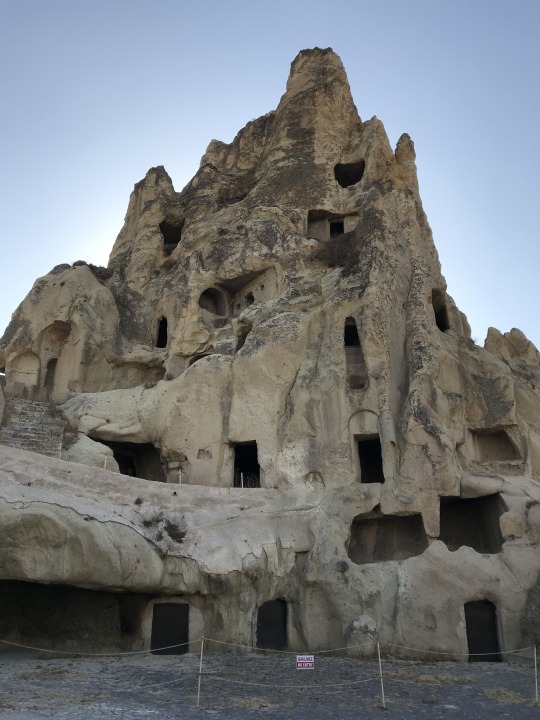
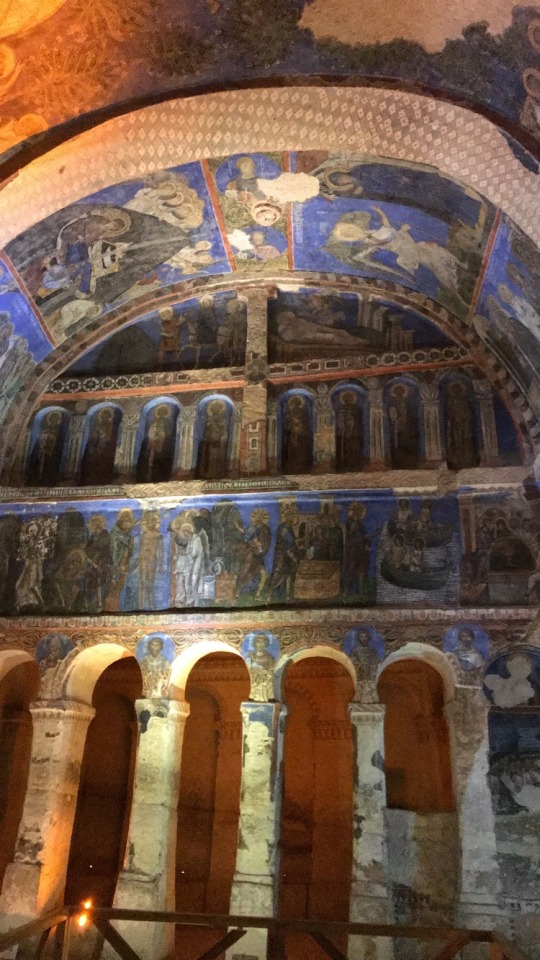
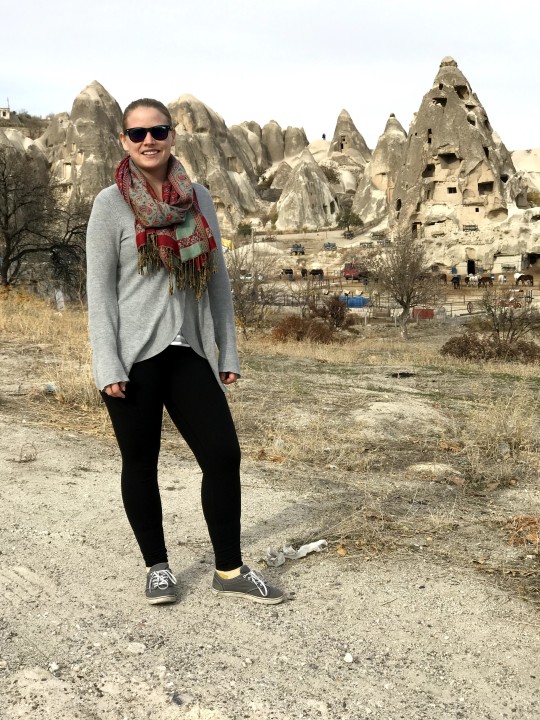
Afterwards, we tried Turkish ravioli (which is a dish from Cappadocia as we came to find out later) and some amazing Turkish samosas (I can’t remember the actual names, so I have to resort to analogizing the dishes). We then took a quick taxi to a small town to the north called Avanos. The main part of town is very nice and picturesque, but we quickly found out the rest of town is not so nice. We bobbled around a bit (and were guilted into buying a souvenir), then we made our way back to Goreme. We were told that the balloon ride would be canceled again the next day, so Mariah scheduled a consolation prize- a hamam bath.
This was a real treat- just be sure to check you inhibitions at the door. We paid for a bath, massage, and facial. We started in a sauna, which we really got the sweat going. Then, in just a towel, you lie down on a stone table. A person then dowses you in water and gives you rough luffa scrub up and down your entire body. This is followed by a lavender soap rub down- again all over. You are rinsed and then given slippers to go back and relax before your massage. Too bad my slippers were three sizes too small! The massage and facial were standard, but welcomed. We left the place feeling so relaxed and refreshed. Dinner that night was some of the best I’ve had. Truly a great night.
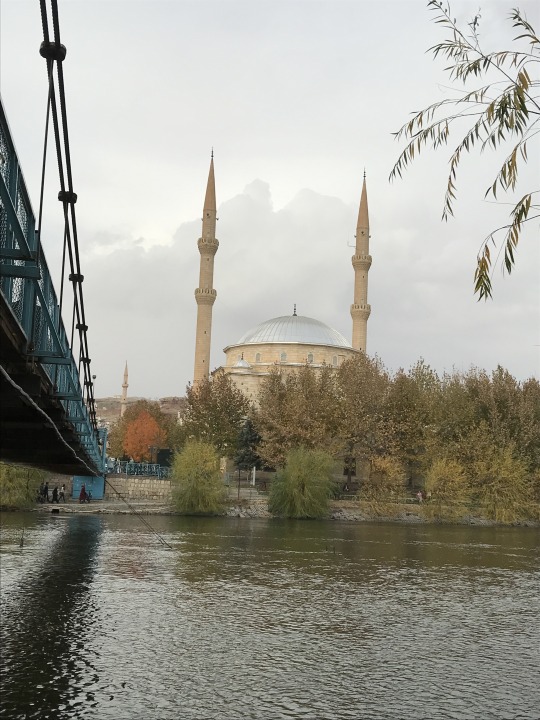
Avanos

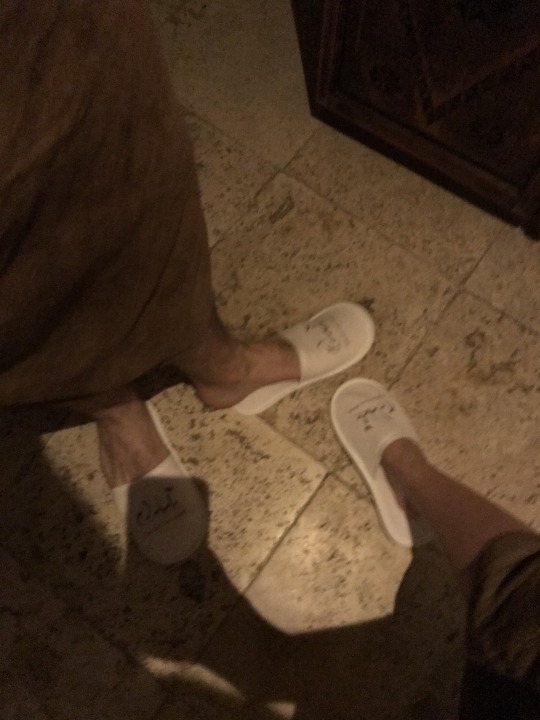
One size... fits all?
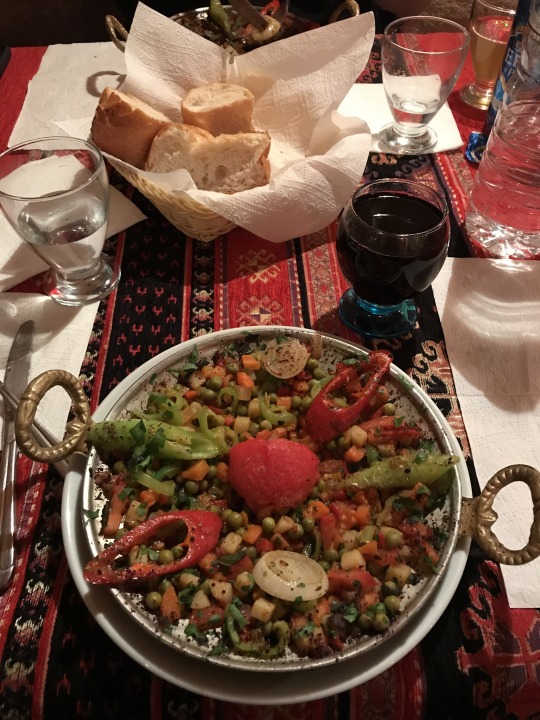
The next day wasn’t too eventful. Honestly we just made our way back to Istanbul, which was rainy. We had some good durum and climbed the Galata Tower for some spectacular views of the city. Plus we had some great baklava. You might be sensing a theme that I enjoyed the food there, which was good because the next day we scheduled a food tour around the city.
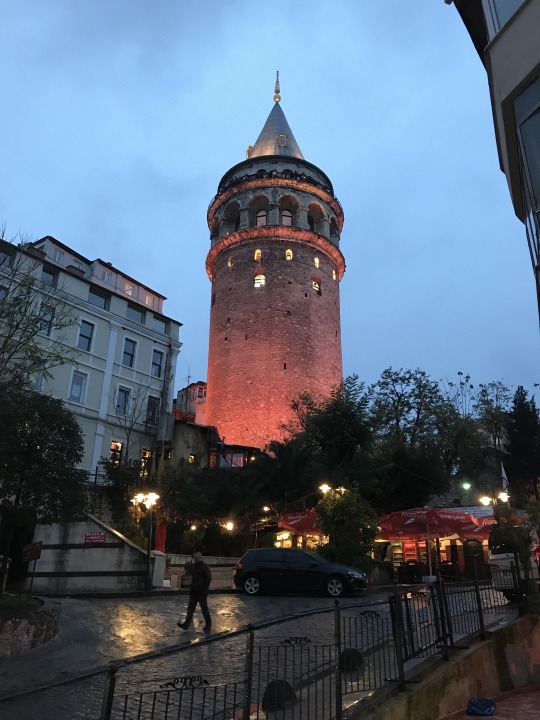
Galata Tower
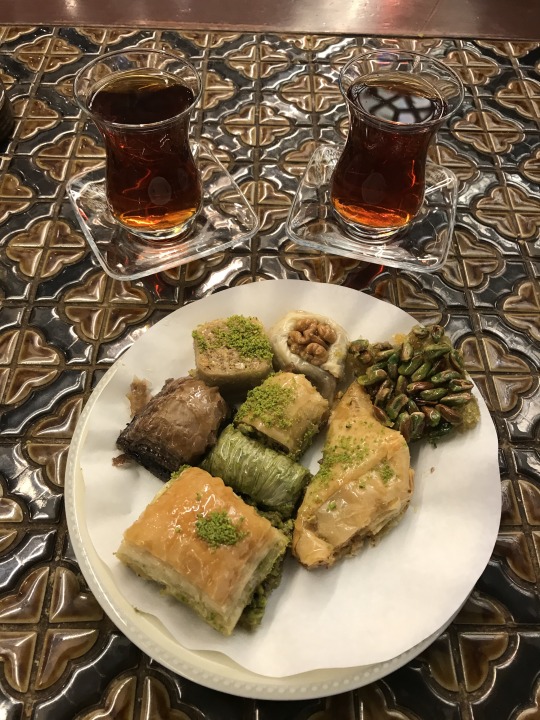
We met our guide, Latif, in the old city. Latif opened up a small local tour company, Istanbul on Food, with his college friend. His friend has since moved to Australia, but Latif carries on the business. I can’t stress enough how good this tour is. Latif has been in the tour game for 12 years, and his passion for Turkey really shows. If you go to Istanbul, book this tour. The food is so good, and there is so much (really too much).
We went on the ‘Taste of Two Continents’ tour, and started the day off with breakfast in the Spice Bazaar. Latif gathered simit bread, various cheeses, Turkish pastrami, menemen (eggs with peppers and tomatoes), clotted creamy and honey, and both chunky and smooth hazelnut butter. Holy shit, everything was amazing, but the smooth hazelnut butter was dangerous, which shouldn’t be a surprise given it was basically Nutella without chocolate. Afterwards we hopped on a ferry over to the Asian side of the city. While it was chilly, we sat outside and caught some amazing views. In the meantime, Lafit shared how the Asian side, specifically the Kadikoy neighborhood, is, ironically, situated more like a European city than the European side of Istanbul. After living in Europe for a year, I completely agree. It really is an intangible feeling, but Kadikoy was hip and trendy, and very enjoyable. To hammer home the European feel, we started at a sweet shop by the port. There we had salep, a spiced hot drink made from orchid flour. While the Salep was good, the really cool thing about the shop was the Christmas sweets that they sold. Turkey, as you may know, is predominately an Islamic nation. However, it is a secular nation, and very open to people of other faiths, as evidenced by its sale of chocolate Santas. It was very heartwarming to see Latif relive childhood memories upon sight of the chocolate Santas which he used to have as a kid growing up in Germany (Germany has the largest Turkish population in Europe, outside Turkey).
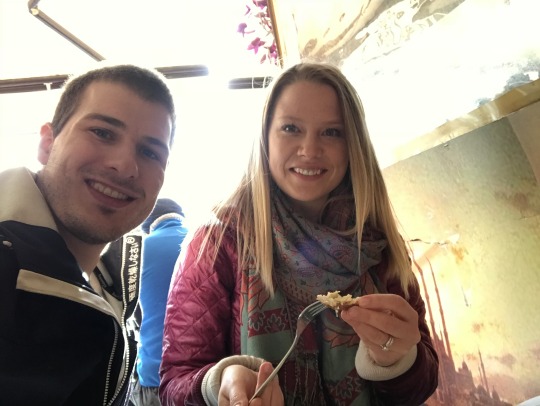
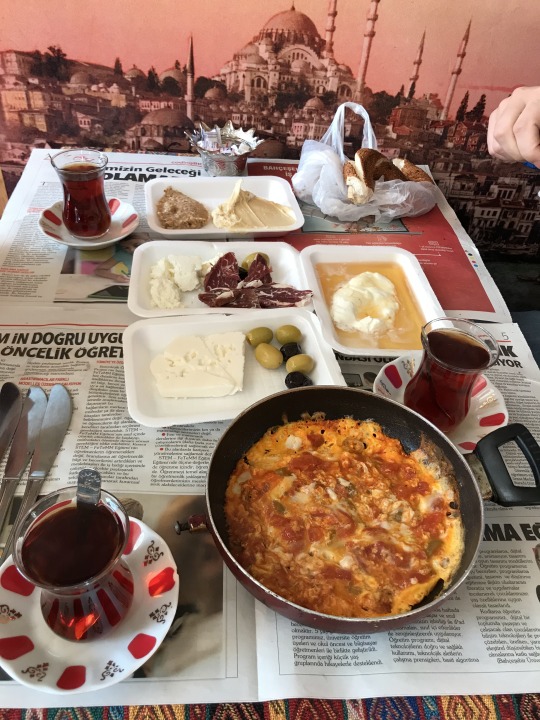
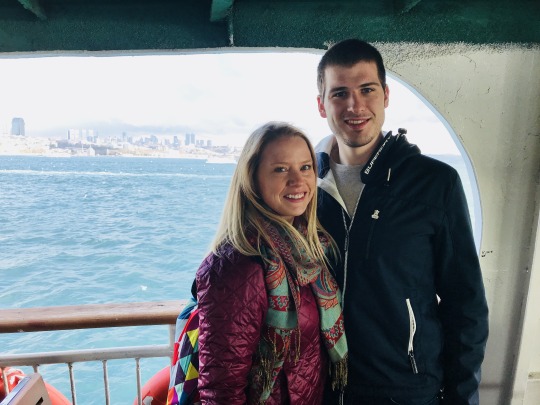
From there, we had lunch at Ciya, which is widely regarded as the best lunch in the city. Each day the restaurant has a new menu of various dishes from regions throughout the country. We had samples of two different stews, baba ganoush, stuffed eggplant, puff bread, and Turkish pizza. Seriously, SO. MUCH. FOOD. And this was stop three of 12. The next stop was to the originator of a special type of donor kebap- an iskender kebap. This one doesn’t come wrapped up, but is rather eaten like an open-face sandwich and smothered in tomato sauce. And it is considered more upscale than the common street food version. Luckily, after this stop we a stop for some lighter fare- traditional pickled veggies. We had cucumbers (ie pickles), beets, cabbage, carrots, tomatoes, and even a plum. The plum was weird, but we cleansed our palate with a mix of pomegranate molasses and tahini. Yum!

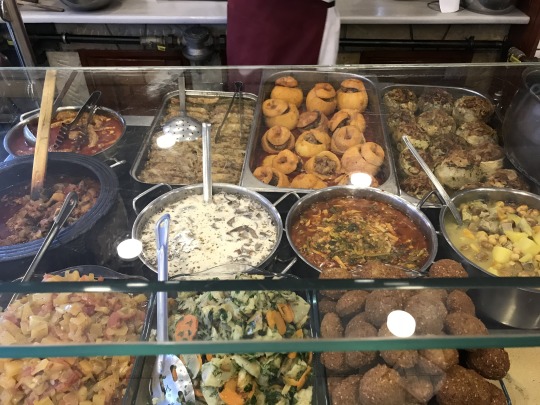
Next we walked over to a street stand, and tried some mussels. We had both fried and steamed- the steamed was mixed with rice and lemon, and was heavenly. Well, at least for me… not sure Mariah thought as much. But our next stop was for tantuni. This was described as Turkish tacos, and that’s pretty accurate. They’re even better with hot peppers! The sour yogurts drinks that came with them were pretty awful, though. Latif said every American he’s taken on tour has hated them, so there’s that. Next was kokorec, which, stay with me here, is pig intestine wrapped around tripe, roasted, diced, and served in toasted bread. Actually not too bad, but I wouldn’t make it a habit. Supposedly, the EU is cracking down on kokorec for sanitary reasons (Turkey is/was half-heartedly trying to join the EU), which is probably a good call. Next is a quick stop for raw meatballs, which is actually meat-free, and made from walnuts. Supposedly, the original recipes called for meat, which wasn’t cooked due to a punishment from god, but now is made from walnuts. It’s actually decent.
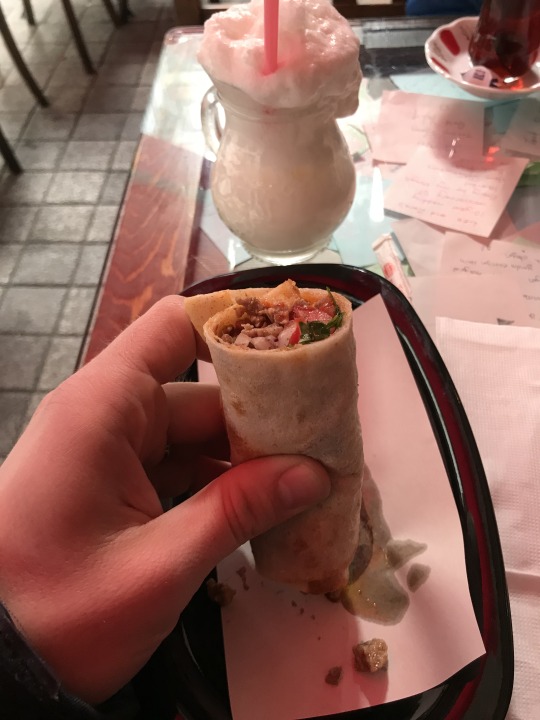
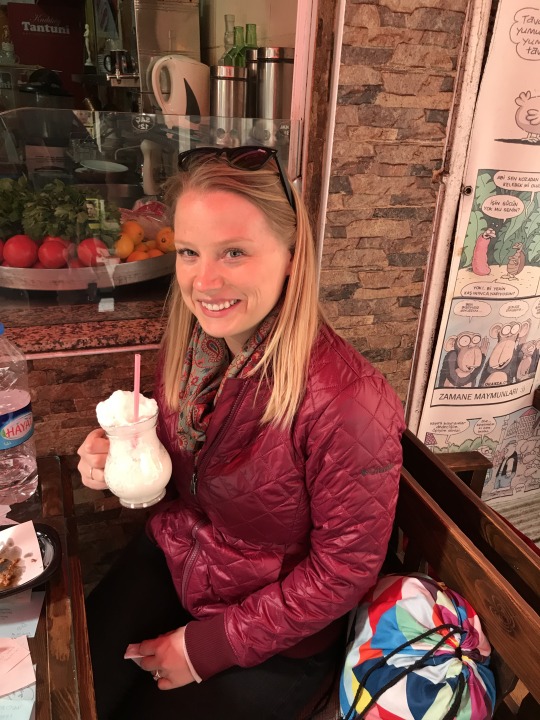
Unfortunately, this is not a milkshake- it is a salty, plain yogurt beverage!
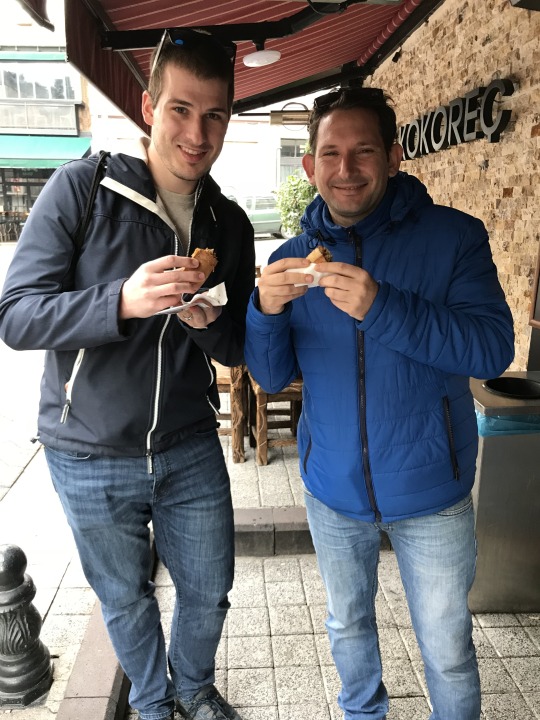
Ok, so now after a few lighter stops, we went to a small pide restaurant. Pide is a popular dish in Turkey. It is sometimes called Turkish pizza, but Turkish pizza often refers to the flat pita with a meat and tomato spread. Pide has a thicker crust, and layer with cheese and toppings like a typical pizza, and sometimes wrapped like a calzone. It is delicious. We had a veggie (which unfortunately included mushrooms to Mariah’s chagrin), and was the absolute best thing we had all day. In fact, Latif didn’t really eat all day (he tries to keep from eating too much on the tours to keep from gaining weight), but indulged here. My only regret is that I forgot to take a picture of the restaurant, and I can’t remember the name.

I don’t think she can eat any more
On the final stop, we stopped at a local ice cream chain- Mado. While a chain, this has the best ice cream according to Latif. We had some traditional Turkish ice cream, which is made thicker and richer than the American version. We were also treated to a surprise birthday cake, courtesy of Latif. SO. MUCH. FOOD. Also, I forgot that we had some delicious baklava and Turkish coffee (no, you don’t drink the grounds that are left in the cup). Latif even treated us to an extra treat of pudding made from barley/wheat topped with cinnamon and chickpeas. It was good (truly), but we could barely eat it after stuffing ourselves earlier. After the tour, we wanted to see the Taksim neighborhood, which is where Latif’s evening tour was located. So he accompanied us and gave us a few more tips. We thanked him and explored the neighborhood, including a holiday market, an orthodox Christian church, and an extremely lavish high school. Then we went up to a brewery to close out the night. If I were hungry, I would have tried a burger, because they looked delicious (the beer was decent). We called it a decently early night, but were pleasantly surprised when our hotel left us a complementary chocolate cake for Mariah’s birthday. We made room. Overall, I think we can call this a birthday success.

Just kidding - she made room
The next day, we hit up all of the hot tourist spots of the city. We went first to the Blue Mosque. The architecture is tremendous, but I feel that the lack of décor within mosques leaves them feeling empty. Outside the mosque we were harassed by a vendor who wouldn’t take no for an answer, and despite our best intentions, we admittedly fell a bit into his tourist trap and bough some spices and candies. After that annoying side quest, we went to the Hagia Sophia, which was the grand church of the Byzantine Empire in the mid-6th century, until being converted to a mosque in the Ottoman Empire. Now it is a museum, and houses the art from both eras. Additionally, there are some neat tombs for old sultans of the Ottoman Empire. Afterwards, we toured the Topkaki Palace. The palace was grand, but I’m still palace’d out. There were some beautiful views that made the entrance fee worth it, though. What I was really excited for were the city cisterns, though. These used to house the water for the whole city. It was pretty cool seeing the setting for (*spoiler*) the climax of Dan Brown’s Inferno. Finally, we walked through the Grand Bazaar, which is really a glorified flea market, before getting a small bite to eat. Oh, and we saw a surprise aqueduct along the way. Not much more going on for the rest of the evening.
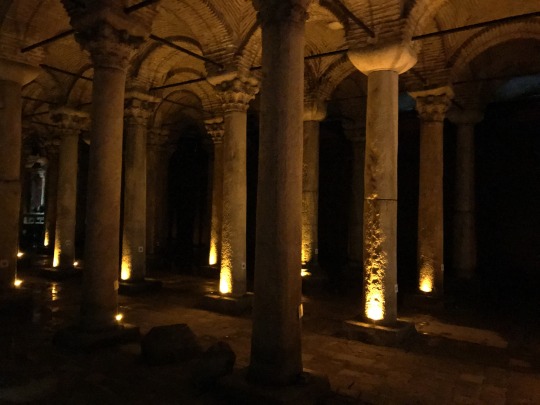
Underground cisterns

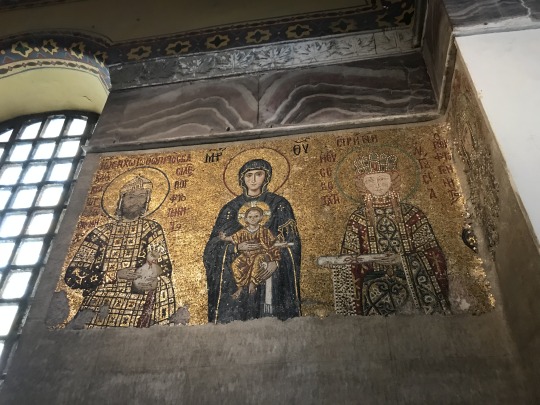

Hagia Sophia
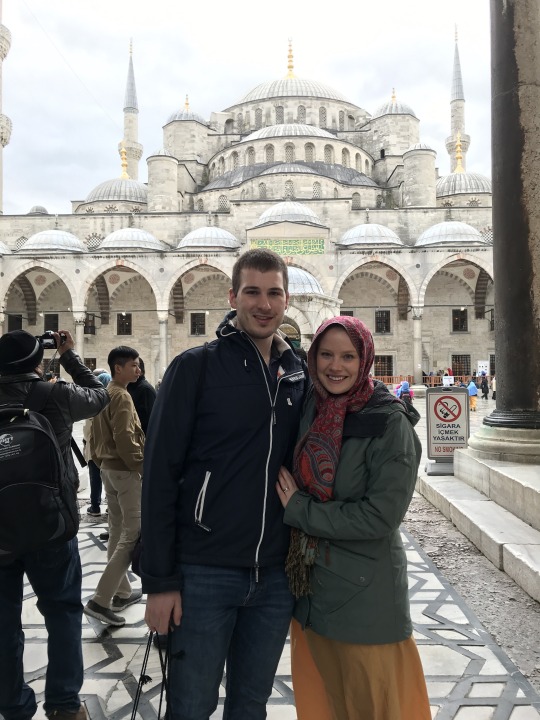
The Blue Mosque
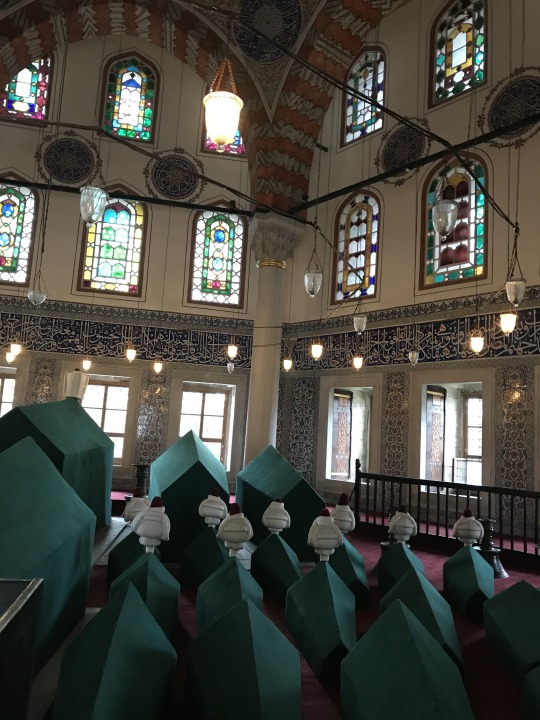
The tombs of young princes
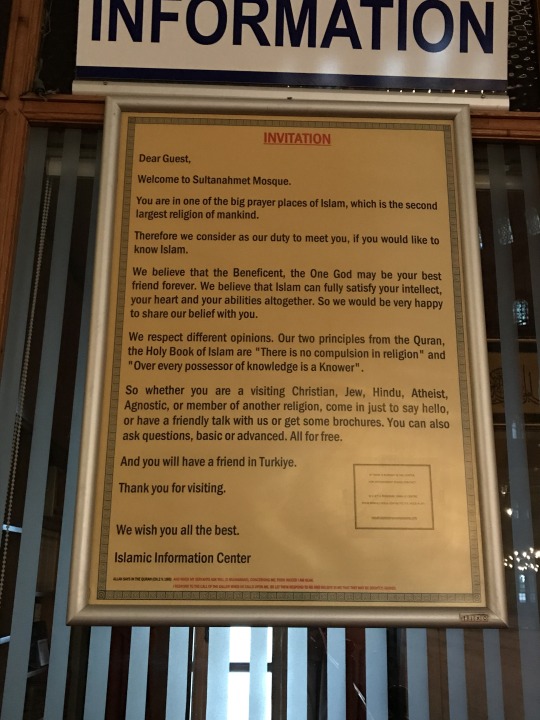
Alright, so now we are on to the last leg of the trip. We went to the airport to hop over to Athens… literally, we were going in a puddle hopper. I may have been in a prop plane before, but I honestly don’t remember it. I even got to have the window seat right by the engine- some cool photos ensued. We traveled with an interesting set of characters, including an American diplomat (hopefully she made some progress while she was in town).
Upon arriving in Athens, we of course went to find food. To our surprise, Turkey was really lacking solid falafel, despite being neighbored by several countries in the Mediterranean that specialize in it. That wasn’t a problem in Athens! We arrived in the afternoon, so some of the sites had closed their entrances early for winter hours. However, we still got to see some cool stuff, including the first arena for the Modern Olympic games (side note- don’t pay to go in, you can see it all from the outside). We also walked through the city garden and found a little pond with so many turtles! They had even stacked on one another- super cute. We then climbed up toward the Acropolis (but not actually to it- that would be for the next day), and watch the sun set over the city. It was gorgeous. We walked around the city a bit more, and found some awesome street art. We also found a beer bar, which had some solid brews.

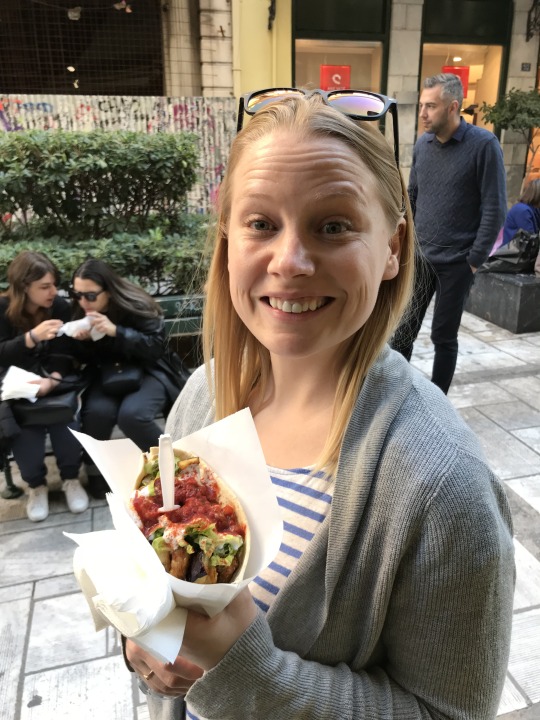
First falafel!
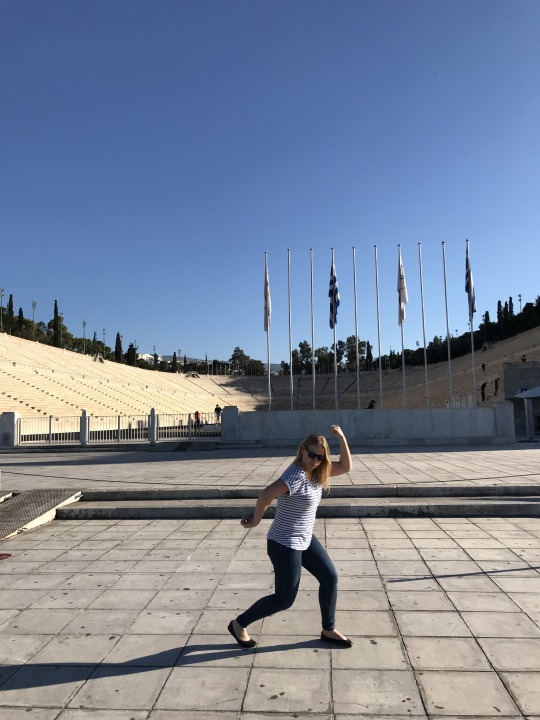
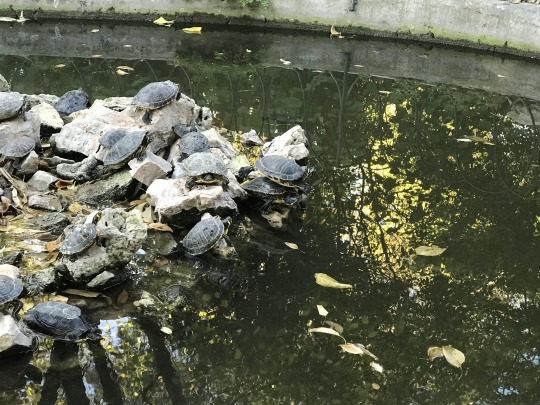

We started the next morning with brunch! Mariah had a Greek omelet, but I tried something new. Alas, I again can’t remember the name, but it was basically orzo-esque pasta, tomato sauce, and eggs. Mix it up, and you have deliciousness on a plate. We then split Nutella stuffed pancakes. Yum! Then we went up the Acropolis. Yes, it is worth it. The views are amazing. Just check out the pics. We also went to see the agora, which is cool, but probably not entirely worth admission. BTW, despite Greece not having the best economy, they sure know how to price admission to their attractions. They take a page from Disney, and charge the maximum you’re willing to pay, cause, I mean, you’re not going to not see the Acropolis. As a side note, I was actually surprised at the number of Americans I saw around the city, considering it was Thanksgiving weekend. We got some souvlaki (basically gyros), which by now you probably know were amazing- you just have to wait in line for an hour or so before getting some.

Pretty excited about having a Greek omelette in Greece!

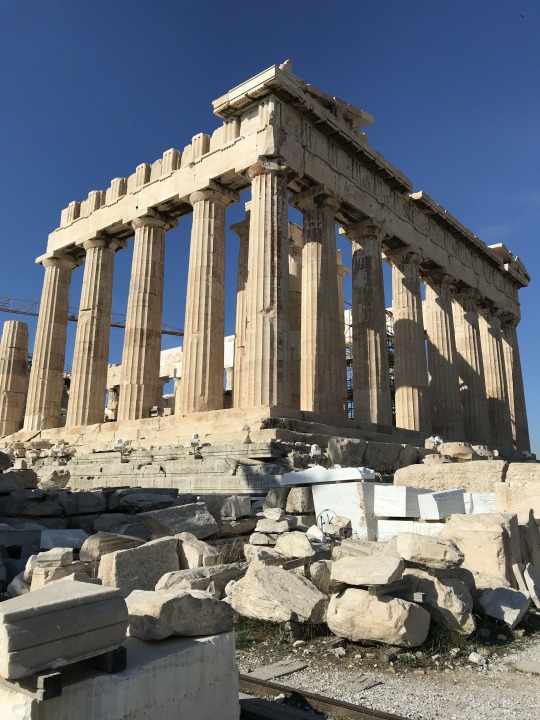
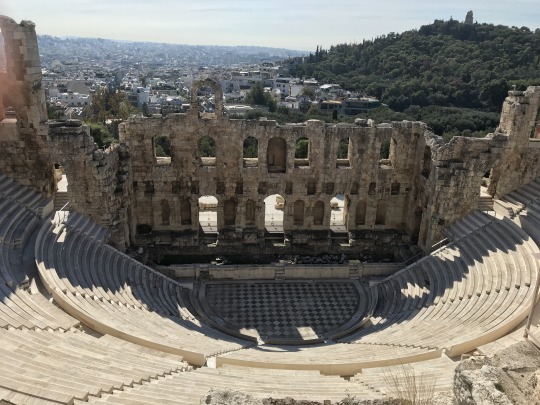
A view of Hadrian’s Arch and the Temple of Zeus from the Acropolis
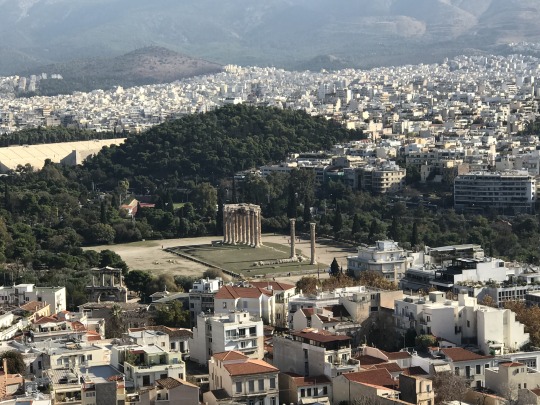
That evening, we caught a drink in a cute coffee house that changes décor for the season. We happened to catch them as they changed for the Christmas season. The drinks were awful, but the atmosphere was really cool. We then found yet another amazing meal for dinner. This place was seriously cool, because it was a family deli with a dinner service. They not only give you free bread, but also pastrami and cheese as a free appetizer. We then ordered some dolmas (basically the first of the whole trip) and bulger salad. We also had a pastrami egg dish (well, I did) and a Greek salad. Superb! We then closed with drinks in a trendy bar called the Clumsies. My Celtic Forest drink played with my head a bit, since the ice kinda looks like seaweed.
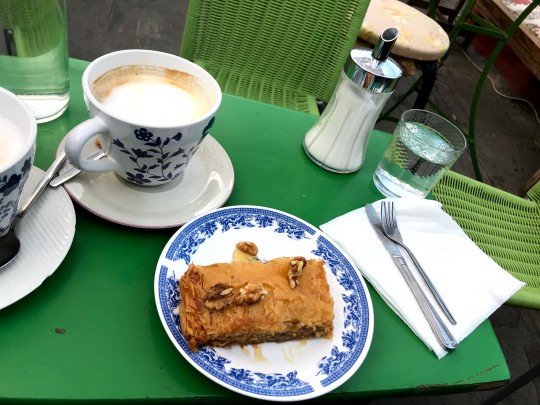
Final baklava

A quick stop for Christmas tea

Seaweed cocktail?
The next morning, we went home. It was particularly interesting, since we (ie, the whole plane) were immediately stopped after landing by border control. This was very odd since we were traveling from one EU member country to another. Fortunately, we were able to pass with no problems (even though Mariah had to check her hand luggage at the gate so she didn’t have her passport). At least we made it back in time to join our friends for a belated Friends-giving celebration.
To say the least, this was an epic trip. Easily one of the best we’ve had. While I miss our family, and the traditional food, I loved trying out this Turkey for Thanksgiving, even if it was a bit Greece-y…
…
Ok, that was a bit much. Tot ziens for now!
2 notes
·
View notes
Text










September 13 and 14, 2019
Friday morning Ingvar and I woke up at Mom and Dad’s on Camano Island around 8. I did my hair and makeup and Ingvar made himself some coffee. Dad came home after 9 and drove us down to Costco in Smokey Point, where Mom was working until 11. Thanks for the ride, Dad! We dropped our bags off at Mom’s car, then headed over to Target. I had booked our flight to Copenhagen with Norwegian Airlines, which is a budget airline. They weren’t going to feed us or provide drinks, so that’s what we did at Target. We got sandwiches, trail mix, and granola bars.
Right past 11, we met Mom at her car. The drive down to SeaTac wasn’t bad! Mom shaved off 12 minutes of drive time by being in the HOV lane and speeding a little. Thanks, Mom! We got to the airport right around 12:05. We said goodbye to Mom, and then I had to run into the bathroom! We checked in for our flight and checked our one bag at the desk, then headed through security. We got through pretty quickly, with a dog sniffing us all, expect we had to unpack my bag, which had four pounds of powdered Gatorade in it, for Ingvar’s friend, Nico. Apparently you can’t get that in Germany, so we’re bringing it for him. Our gate was A20, conveniently next to the lounge I get into for free, with my Chase credit card. It takes ages to walk all the way there! Our flight started boarding one hour early, which seemed excessive. So, we stopped at the lounge and had one glass of champagne to toast to our trip!
When we went to our gate, we realized it was a bus gate. We had to bus to our plane, so it make sense that boarding started so early. I started feeling a little anxious, because it was so hot! I had on a long sleeve shirt and my back pack was pretty heavy. Ingvar changed backpacks with me, and I drank some water, so I was good to go.
We took the bus to our plane, and it was a big one! A Dreamliner. Ingvar and I got seats together! Yay! I didn’t pay for that, so I was really happy it worked out. We had seats 27 D and E. We were in the middle section of three. And we were behind the mid cabin bathrooms, so we had tons of leg room! I was happy for Ingvar, since he’s so tall. We got settled, but couldn’t keep our bags in front of us, so we just grabbed our headphones.
Both of us were pretty snoozy, so I was asleep by take off, and Ingvar was somewhere around there, too. I slept for an hour and Ingvar did for two. We watched two and a half episodes of Stranger Things season 3 on my phone, to finish out the season. It was pretty good! We both napped some more, ate some of our snacks, and played trivia together. Did everyone know this was our first flight together? Surprisingly, it is! Ingvar listened to some podcasts and I wrote, and also did some research for our trip! I hadn’t done a ton, with all the trips before this taking up space in my brain, so I’m really glad there was free WiFi on the plane! I mapped out a lot of places where we wanted to go and researched the cities.
Our layover at London Gatwick was just under two hours. We had to go through security again and that was actually a hassle! They only had one X-ray belt open, and they had has take out all our liquids and foods before putting it through. They were super strict about liquids! All mine had to be ran through again, in two small bags, while all my stuff was supposed to fit in one! Thankfully the guy let Ingvar “take” one of my bags so I didn’t have to throw things away. A bunch of ladies had to get all their stuff gone through again, it was a pretty big mess!
Ingvar and I tried to go into a lounge with my card, but it was full. The airport was super crowded, so we just sat for a bit, then headed to our connecting flight. Our next flight was on Norwegian. It was just under two hours, but we left about a half hour late, because we were waiting for ten passengers? Any time we wait for passengers, I always with my plane from San Francisco waited for me, hahah. Ingvar and I ended up snoozing most of the flight. We were tired!
We landed in Copenhagen just after noon. We went through passport control and grabbed our suitcase. Did I tell you Ingvar and I are sharing my Away suitcase that I got for Christmas? And we each have a backpack. So we collected our bag, then followed the signs for the metro. I knew which stop we needed to get off of, for our hostel, Generator Copenhagen. We easily bought a ticket, then took the metro for about 15 minutes to our stop. It was only a ten minutes walk, and then we were at the hostel!
I was so happy! Ingvar was in Europe with me! His first international trip. We checked in to our 5 story hostel, but didn’t have access to our room until 2–about forty minutes away. We checked out the hostel common area, and decided to have a Danish beer, Carlsberg, while we waited! We hung around and used the WiFi, then at 2, headed up to our room. We were in a 8 person room, with four bunk beds. I took the top, so Ingvar could have the bottom bunk. Ingvar took a shower and I laid down for about an hour. We definitely didn’t get enough sleep on the plane. Ingvar walked around outside while I snoozed, then around 3, I washed my face and changed, because the hostel put on a free walking tour at 3:30!
Ingvar and I went down to the reception and met a guy for the walking tour. He walked us to the meeting point of the tour, where Ingvar and I got a snack from the 7/11. 7/11s are actually pretty good here? Ingvar got a skewer of chicken and I got a hot dog in bread, and we got a beer to walk around with. You can drink in the streets and in public, which is wild!
Our tour was of Chistiania! Christiania is a free town, in charge of its own government and daily running. It was created by hippies in the 70s, who wanted less government control of their lives. Christina has had problems of hard drugs on the past, but now it is currently accepted to sell hash in Christiania. Our tour guide was Jakob and he took us around some of the canals. Copenhagen is made up of more than 100 islands, separated by canals. He gave us history of Denmark and Copenhagen, and brought us to Christiania. He wasn’t allowed to bring in a larger tour group, but we went in on our own. Ingvar and I walked through “pusher street”, where dealers were selling hash. Families live in Christiania, and the vibe is really care free and relaxed. Hash is a weird thing, though, because it’s still illegal in Denmark, but sold in Christiania.
After the free walking tour, we asked Jakob where we should eat dinner. He recommended the Copenhagen Cafe for Danish food. We had to walk a bit from Christiania, but we made it! Our feet were tired, so we were happy to sit down for dinner. It was pretty chilly, but not too bad. For dinner, we got the classic Danish meal, smørrebrød, or smorgasbord. Ingvar and I shared minced beef with a fried egg, Danish meatballs, marinated herring, and liver pâté. It was all put on rye bread and had open face. I looooved the pâté! I didn’t really like the marinated herring, but I was happy to try some super Danish food. We also tried akvavit, a liquor from Denmark. It was pretty strong!
We were super tired after dinner, so we walked back to our hostel. We both accidentally took a half hour nap, then I showered and we both go ready for bed. We met a couple nice people in our room, but we were soooo tired! We were both asleep by 10, for sure. What a day! I’m so happy to be in Copenhagen with Ingvar. :]
#seattle#seatac#washington#washingtonstate#usa#america#denmark#copenhagen#kobenhavn#london#uk#england#plane#jetlag#hostel
0 notes
Text
From Chapati to Sticky Rice
People who have spent considerable time in India have repeated to us time and time again the same line, “India will change you.” And to neither of our surprises, this turned out to be the case. Here are few examples:
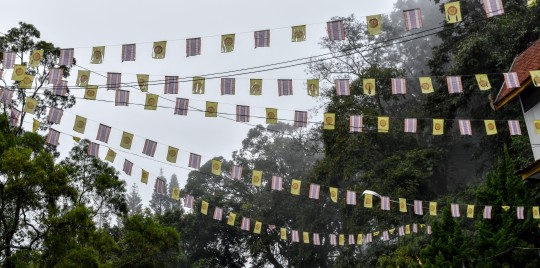
We learned quickly that every day would be a challenge, and that nothing can be taken for granted in India. Getting from A-B, finding a restaurant, finding a pharmacy, finding a bathroom, heck even walking next to each other in a crowd can be tough in Delhi. Travelling here forces you to maintain a calm and composed state of mind even in the most trying of situations. Given that timetables and stated schedules are meaningless, letting yourself get flustered at the first hiccup can be a trip ruiner.
True Statement: If you can travel in India, you can travel anywhere in the world.
We experienced sensory overload pretty much every day. I’ve never been in a place that had so many smells, sights and sounds ricocheting off each other at all hours. While we continuously felt overwhelmed by this, we soon learned to appreciate the vibrancy of the everyday chaotic routine of India.
Living healthy is incredibly easy to do when you put yourself in a healthy environment. For two months we didn’t eat meat, rarely drank alcohol and didn’t consume dairy. Restaurants aren’t marketed as “vegan” or “farm to table”... they just are. We found ourselves sleeping incredibly well, practicing yoga nearly every day and reading more than we ever had in our lives. There is a reason that India is the yoga and meditation capital of the world… it is the perfect cure for the everyday chaos of living in such a country. Our New Year's resolutions are to continue this healthy lifestyle as we continue our travels and re-enter the “real world” in April.
India constantly reminded us that the best way to get our questions answered was by talking to other people. Finding information online, if it exists at all, is often outdated and incorrect. The blogs we were reading tended to be 3-4 years old, and many of the restaurants/attractions we went out looking for had inaccurate pins on Google Maps. Instead of burying our heads in our iPhones, we were reminded of the old fashioned way of asking for help. Human-to-human interaction, to no surprise, was our lifeline when we were lost or confused (which was often). Locals were more than willing to point us in the right direction after we showed them a restaurant/guest house on on phone, and a few times they even walked us where we needed to go (without asking for anything in return) just to make sure we didn’t get lost.
Most important of all: trust your gut. If you don’t like a guesthouse, leave. If you don’t trust a taxi driver, look for another. If a menu looks questionable, the food is probably also questionable & you should keep searching. Letting your gut and intuition guide the way is the only way to survive long term travel in India. Decisions should be made from the heart and from the gut, not because a guidebook says something or Trip Advisor suggests it. The best way to experience India is through an open mind and flexible schedule. Things will go wrong, and your ability to roll with it will make or break your trip.
When we get asked about out two months in India we speak in incredibly fond and honest terms. We say “It’s crazy. You should go. You need to go. If you are able to slow down & let things happen how they may, travelling in India will simultaneously astonish you, startle you, and ultimately, change you.”
See you later India!
And just like that… exactly two months from the day we landed in Ft. Cochin, India, we hit the road for Chiang Mai, Thailand! Our 21 hour travel day looked something like this:
Alarm goes off at at 2:30, 2:35 & 2:40am in Delhi 3am taxi from Delhi guesthouse to Delhi airport 6am flight from Delhi to Calcutta 4 hour layover in Calcutta 2pm flight from Calcutta to Bangkok 8pm flight Bangkok to Chiang Mai 20 minute taxi from airport to guesthouse Bed at 11pm
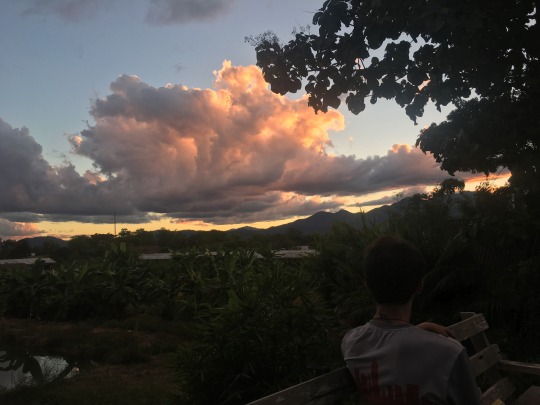



^^ That is a cricket :)
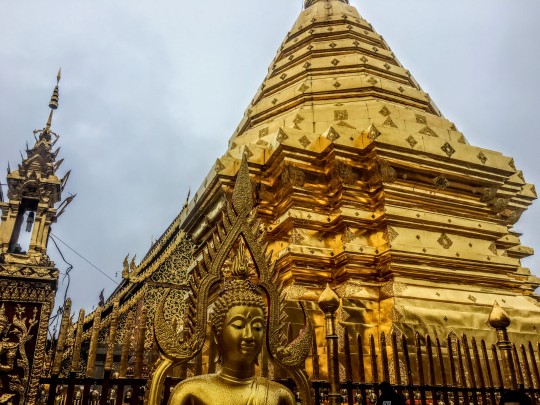

From the moment we were dropped off in front of our guesthouse in Chiang Mai, we were struck by the silence that surrounded us. People weren’t honking their horns, dogs weren’t barking, construction wasn’t being done on every corner… we could even walk side by side without the fear of being run off the road. Compared to Delhi, Chiang Mai felt more like Disney World than the second biggest city in Thailand. It was refreshingly eerie.
Chiang Mai is the capital of Northern Thailand, and one of the most popular tourist destinations in the country. The charming “Old City” is a one-mile by one-mile grid, surrounded by a picturesque moat dating back to 1292. Buildings don’t rise above three stories, and there are cafes on every corner with reliably fast wifi. The developed, yet chilled out vibe of the city is what makes it one of the most frequented destinations for digital nomads and expats to settle in.
We spent our days exploring the city by pedal bike, and our nights eating street food at the market and listening to live jazz at a bar down the road from our guesthouse.
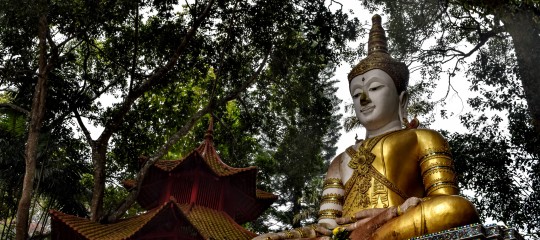


I ran a few times while in India, specifically in Goa, but gave up after being chased by dogs on more than one occasion. In Thailand I was able to run again, with the boundaries of the Old City creating a perfect four mile running path.

One afternoon we ventured into to the beautiful countryside for a traditional Thai cooking course. We arrived at an organic farm 30 minutes from Chaing Mai, and promptly went to work pounding green curry paste, stir-frying pad thai and chopping ingredients for papaya salad. After these dishes were cooked and eaten, we escaped to a set of hammocks overlooking rice paddies to sleep off our meal. An hour later, we were awoken by the chef to begin cooking our second round of food: fresh spring rolls and mango sticky rice. It was a successfully glutenous day.
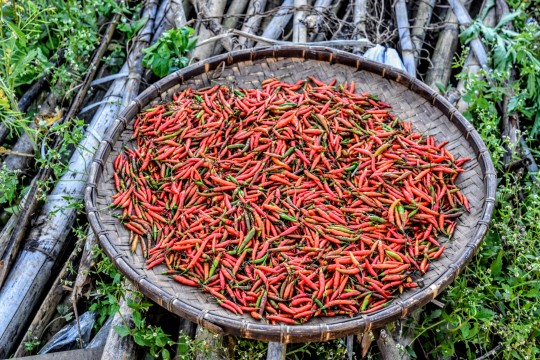
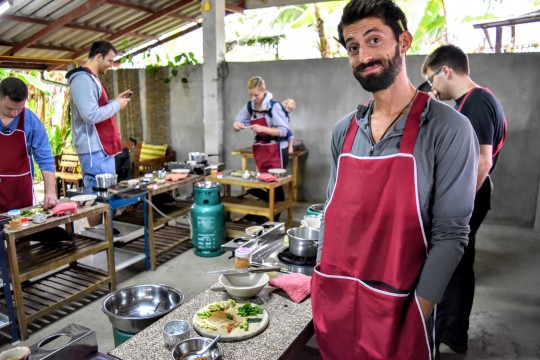
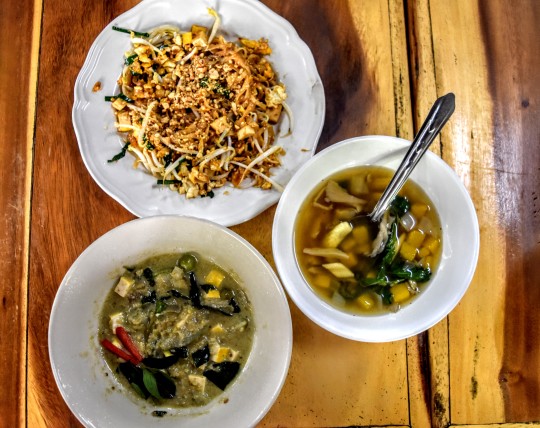

7-Eleven's are on every corner in Thailand and are the perfect place to escape the heat (the AC is always on full blast). You can find everything from soy chocolate milk to fresh mango, and even pay for bus tickets at the checkout counter. Even the most run down 7-Eleven in Thailand is more helpful than most of our hostels were in India.
Almost equal to the number of 7-Elevens in Chiang Mai are the number of Thai massage parlors. In an effort to discern the quality establishments from the ones looking to prey on backpackers, we followed the suggestion of our guesthouse owners and went to their favorite place. A Thai massage is more in line with a 60 minute full body stretch session than a traditional western relaxation massage, which is why they get mixed reviews from travelers. The masseuse takes full advantage of their feet, legs, elbows and forearms in their attempt to stretch and contort our bodies into once thought impossible positions… and we loved it. At $6 USD for a full hour, it is no surprise that I returned a few days later for a follow up.

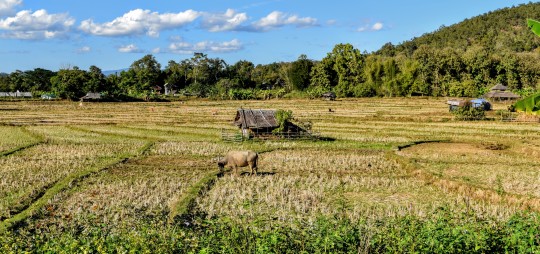
One afternoon we took out 40-year-old rented bikes and ventured to the only public park in the Old City. To our delight, the park was in pristine condition and full of westerners doing acro yoga, tai chi, and slacklining. We spent the next few hours doing yoga, reiki, reading, napping and admiring the acrobatics going on around us.
I’ve been getting beard trims throughout our time abroad, but the time had come for a proper haircut. We asked our guesthouse for a recommendation, and after showing us on the map where the nearest place is, they warned us not to go after 5pm because that’s when the barbers start drinking. It was 7pm... and we decided to give it a go anyway. When we showed up the whole family was having a big feast outside the parlor, complete with several bottles of alcohol scattered on the tables. They greeted us with big smiles and welcoming “Sawadees” (hello in Thai), and we asked, “Haircut?” A woman who looked like she hadn’t been drinking (too much) jumped up and led us inside. She threw a towel over my shoulders, we exchanged less than 10 words about what I wanted, and she started clipping away. Twenty minutes later, I had a fresh haircut and beard trim. If she had been drinking, she hid it well.

Once a quiet and somewhat remote town in Northern Thailand, Pai is now properly on the backpacker trail in SE Asia and can easily be accessed from Chiang Mai by a 4 hour minivan ride than includes 762 turns (they sell shirts in Pai say “I survived the 762 turns to Pai”). Once you make it through the harrowing journey, you are greeted by a delightful town full of vegan restaurants, reggae bars & backpacker bungalows. Pai tends to get a bad rap from old timers and long term travellers because of how rapidly it has changed over the last 10 years, but to us it was an oasis. The resort -- yes we stayed at a “resort” -- where we spent the week was 12 dollars a night for a private bungalow, which included a fabulous free yoga class each morning along with free breakfast.

We hiked one afternoon with our new friends from Auckland to a waterfall just outside of town. Per a few blogs online, we learned that a dog often serves as a tour guide on this particular hike. 15-minutes into the hike, a gorgeous pup strolls out of the woods and joins our ranks. For the next three hours Winston (as we named him) guided us through two dozen river crossings and patiently waited as we took photos at the waterfall. When we were ready to turn around and head home, Winston once again took the lead and showed us the way. Thanks for everything, Winston!

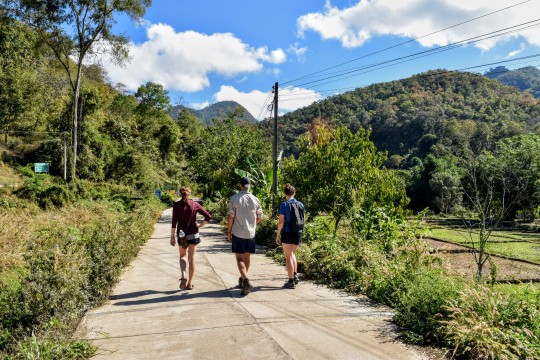

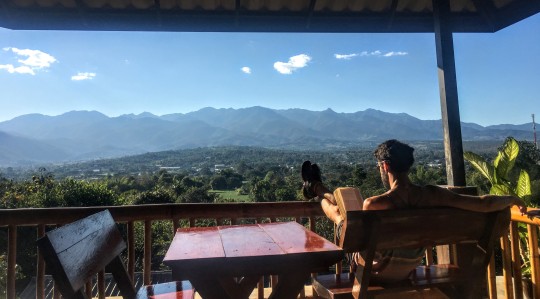
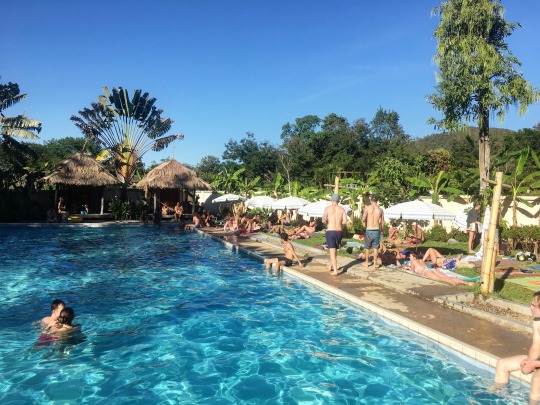
In Pai we went to the 12th Annual Pai Reggae Music Festival. Their were ads all over town highlighting the event, saying the festival was on Saturday and Sunday, started at mid-day and was located on the grounds of a specific hotel just outside of town. We popped the hotel name in Google Maps, saw it was a few mile walk from our place, and opted out of taking a taxi. After a 2.5 mile walk in the hills we made it to the festival!

Just kidding. Google Maps was wrong. We were nowhere near the reggae fest. We headed back into town, and ended up teaming up with other lost souls who were also searching for this mystical festival.
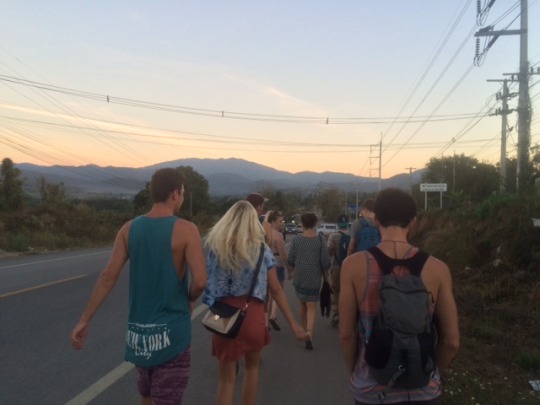
After another 2 miles, we finally made it! It was 4pm, and we soon learned that the festival didn’t start until 7pm. Our first question to ticket counter… “Why does your poster say mid-day?” Their response was, “Great question.”
We headed to the nearest restaurant to grab a beer, and found out that the entire restaurant was full of festival goers who also showed up too early and were now killing time playing cards, drinking beer and swapping travel tales.
We returned at 7pm with a whole crew of new friends, and boogied until midnight. Who doesn’t love Thai men singing in English with a Rasta accent? We sure did.
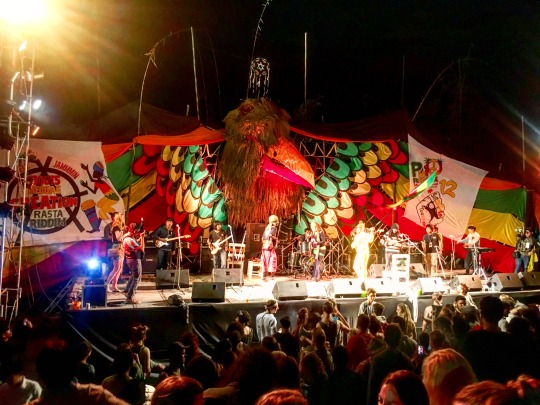
Camryn found a picture on Instagram a few weeks ago of a gorgeous sunrise in an obscure corner of Northeast Thailand that we hadn’t read about in any of our guide books. We asked a few people if they had heard of this magical place called Phu Chi Fa, and no one recognized the name. Immediately, we were intrigued. After two weeks in Chiang Mai and Pai, we were craving an off-the-beaten-track adventure. We got it, no doubt.
After a quick Google search, we read a few blog posts from travellers (dating back 4-5 years) saying that this town was their favorite in all of Thailand and not be missed. Details on getting there were hard to come by, as some said they took a bus there… others said the bus was no longer running and were forced to rent a motorcycle... some hired a private taxi. We chanced it on faith, and showed up at the bus station in Chiang Rai looking wide eyed for a sign saying Phu Chi Fa. And we found it :)
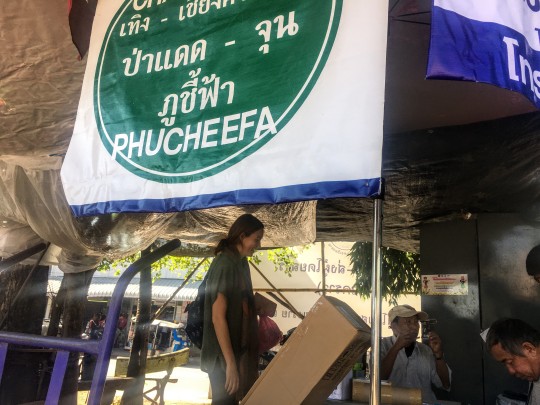
After a casual 3 hour bus ride, we were dropped off in front of a police station in a tiny village that only exists so people can visit the Phu Chi Fa mountain at sunrise. We read online that English is not spoken here, so we were all prepped and ready to use our hand signals and phone calculator to aid in bargaining. After a 15-minute walk down the only street, we found a gem of a guesthouse. We dropped our bags, ate a forgettable meal at a roadside restaurant by pointing at pictures of food on the wall, and went to bed early. Tomorrow’s adventure would come in only a few hours.
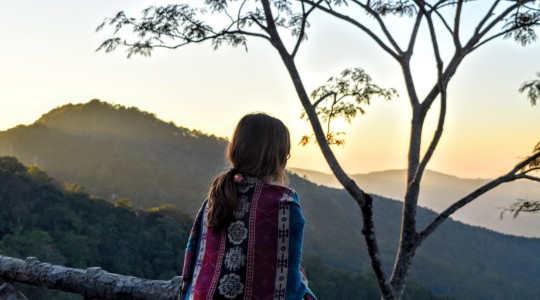

Our phone alarms greeted us at 3:30, 3:35, 3:40 and 3:45 am. We were out the door at 4am heading back to the police station to catch a songthaew (like a pickup truck with benches in the back) to take us halfway up the mountain. We were dropped within a 30 minute hike up to the top of Phu Chi Fa mountain, which we eagerly scampered up by headlamp with all of our warm clothes on.
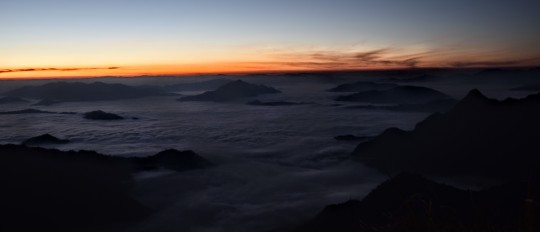

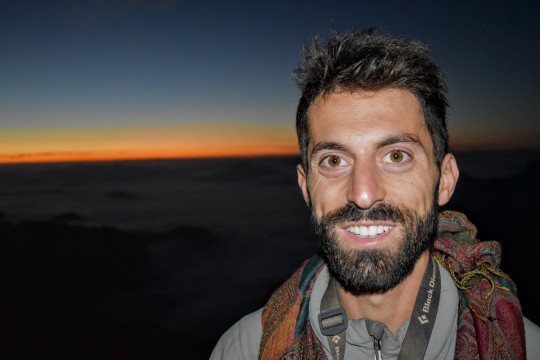
We were one of the first to the top, however within the hour nearly 300 Thai tourists joined us. Not another westerner in sight, to our delight.
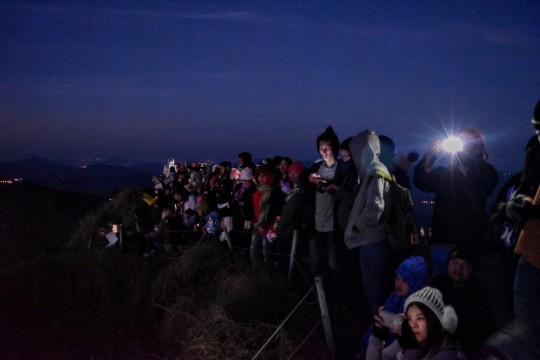
Trying to describe the sunrise would do its beauty a disservice, so I’ll just leave you with the pictures.

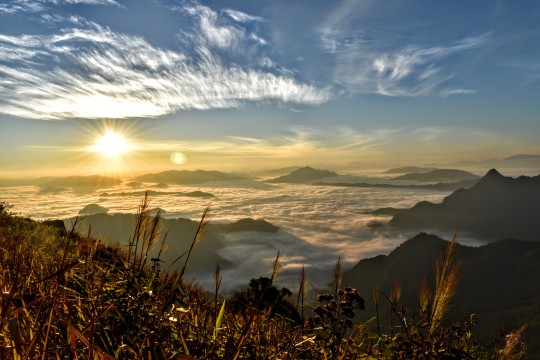


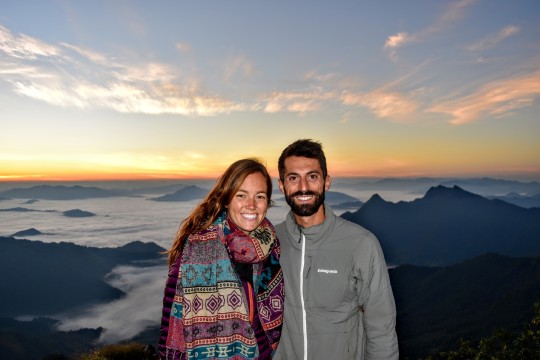
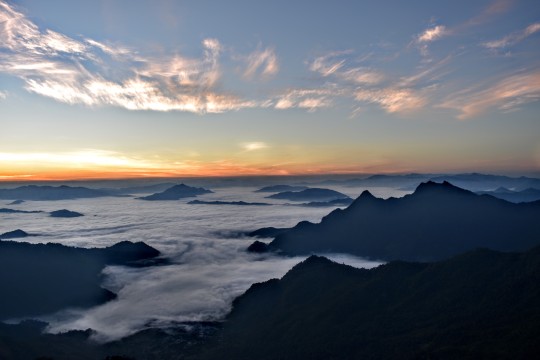
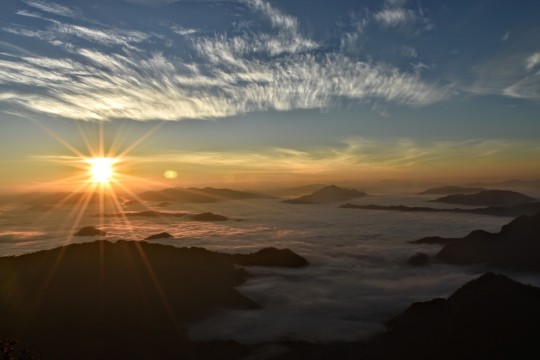
After a few hours enjoying the sunrise, we were back in front of the police station eating banana pancakes waiting for our bus to depart at 9am. Our next destination was Chiang Khong, a city on the border between Thailand and Laos. We arrived at our guesthouse in Chiang Khong and expected our $6USD a night room to be somewhat of a dump, and planned on heading into Laos the next morning. To our surprise, we were greeted by a gorgeous pool and fast wi-fi. Needless to say, we stayed two nights and spent a full day relaxing poolside. Treat yourself, right?

You’ll hear all about Laos in our next post by Cam. Thanks for reading!
Best, JJ
1 note
·
View note
Text
How Volunteering Changed My Life
A common question that is asked in regards to volunteering is “How has this changed your life”. I was thinking about that question one day; as I have been both on the receiving and giving end of social services. I thought to myself, volunteering in and of itself, is what changed my life. More so by being the one that is providing the services. Not because I like the feeling of satisfaction, not because I want to be praised for helping people, but because volunteering, has truly impacted my life in such a way that I will always be eternally grateful for.
Growing up, I was always volunteering. It was a way of life for me when I was a kid. I grew up volunteering in many aspects of my church, I was always a part of the social justice team at my school, I helped out within my community, and I spent my free time on a personal project of mine, that ended up contributing to my church. All I knew, was helping people.
Being able to volunteer my whole childhood, allowed me to experience something that I had been wanting since I even KNEW what volunteering was. I was about 12 years old when I found out that you could go on a missionary trip to help those in undeveloped countries. I heard about it at Craig Keilburger’s WeDay. We Day is what inspired me to help people, and it was truly the first time in my life that I found my passion. After I found out about missionary trips through WeDay and MetoWe, I did everything in my power to make sure I would be able to go. I started babysitting that same year and saved up every penny I got in hopes of coming up with the money for it. I got a job as soon I was legally able to, and saved up for it for YEARS!
At 16 years old, I was sitting in my high school classroom, and on the speaker, they announced that those wanting to go on the Missionary trip to Ecuador in the following year, could attend the assembly happening shortly in the gymnasium. I was jumping, absolutely ecstatic. I had been waiting for this for YEARS! Of course, I went to the assembly and was there in the front row. I learned that I would be staying in the small town of Mondana, Ecuador, and I would be there to build a medical clinic for the town and surrounding areas, while experiencing the beautiful traditions and cultures that Ecuador had to offer. Now, besides having the money to be able to go, I learned that I needed to write an essay on why I feel I deserved to go, I needed good grades and two recommendations letters. I have been volunteering my whole life and saving up for this moment, so to me, not going was not an option.
About 2 to 3 weeks later, the faculty made their decision about who would be going on this journey. I was pulled into a conference room with the faculty that would be attending the trip. As I sat among them, I was so nervous, I was about to be told whether or not I was qualified enough to go. After anxiously waiting for a couple of minutes, I was told that I was one of 28 students that were chosen from over 50, to attend the missionary trip to Ecuador.
I swear, I cried! I had never been so happy, and I never worked for something so hard in my life! I felt so accomplished, and I had yet to even experience the journey in front of me.
It took a full school year of preparations, many, many fundraisers, team building exercises, extra hours and shifts at work, all nighters to finish assignments and keep my grades up, and a fundraiser gala that we held as a team before our journey to Ecuador.
On May 1st, 2015, I was finally ready. To get to the town of Mondana. Ecuador, we had to travel 6 hours by plane to Panama, where we had a 4 hour layover, then traveled 2 hours by plane from Panama to Ecuador. Once we were in Ecuador, we stayed in Quito, the capital city of Ecuador, for two days. While we were there, we got to learn about and experience the culture of Ecuador. We visited beautiful churches, toured the capital and learned about it’s rich history, visited the Equator and experienced new and rich foods special to their country and culture.
After that, we bused 8 hours through the mountains, with a pit stop at the most magnificent fresh pizza place I have ever tasted. After the long bus ride, we took a 45 minute boat ride along the Napo River, which finally took us to our destination, Mondana. We arrived into the heart of the rain forest. I have never been wrapped in so much nature and animal life at once, it was beautiful.
The people at our lodge were so kind and welcoming. We learned that in our 9 days there, we would help build the foundation of the medical clinic, and interact with the community and play with the children. We worked from dawn until dusk, in crazy hot temperatures, bringing sand from one side of the island to the other. We also practiced painting the beams that would hold up the foundation, and we learned how to weld. It was amazing. I experienced such an overwhelming sense of community and became so connected to my team members.
While being in Mondana, we got to experience their way of life. We were shown a lot of the farms of families in the community. We got to visit Mr.Don Vargas’ farm, he was the main source of food and supplies for the entire community! We got to learn how Don Vargas and his family lived a sustaining life on their farm, and we went on a water walk. Multiple times a day, Don Vargas’ wife and child would walk many kilometers down to the stream, to get large buckets of water and bring them back up to the farm. Let me tell you, it was not an easy task! I could not imagine having to do that walk multiple times a day, especially as a kid. We also got to visit a cacao farm, as Ecuador is known for their amazing and natural chocolate. It was truly an amazing and special experience.
At the end of our stay, the community put on a traditional dance with songs of their country and taught us how to dance with them. I never cried so hard leaving somewhere before! I became so close with my classmates/teammates, the tour guides, the community, and the people that worked at the lodge we stayed in and made it home. I grew a lot as a person on my Ecuadorian journey, and found out a lot about myself. I learned that helping people is all I want to do in life, this missionary trip helped me figure out what I am most passionate about.
Now, the point of this blog post was not to brag about the amazing experience I had, or talk about how lucky I was. It was to show how much of a purpose volunteering can give someone. Volunteering can open your heart in ways you did not know it could open. It shows that what you do throughout life, can pay off in your future. Growing up volunteering, is what allowed me to experience something as beautiful as Ecuador, and it allowed me to find my passion in life, helping others.
Thanks for viewing this week's blog post! Until next time…
Xoxo,
S
0 notes
Text
Here’s the Right Way to Plan Iceland Trip
Icelanders like to joke that during the course of their adulthood they’ll have no less than seven careers—oftentimes two at once. In fact, being busy is such a part of the national identity, Icelanders’ most common greeting roughly translates to: “So, busy as always?”
For Herdis Fridriksdottir, who left a career in education to get busier working in tourism, the answer isn’t just “yes.” It’s “more than ever.”
Since 2012, Iceland’s visitor numbers have been growing an average of 32 percent each year. The country gets seven visitors for every local, with travel now contributing more than 10 percent to gross domestic product, making it Iceland’s largest economic sector.
If “overtourism” has become a red flag for the global travel industry, Iceland is a prime example. Some sites are at risk of closing, or have closed, like Fjaðrárgljúfur canyon featured in a Justin Bieber music video. (Even if tourism numbers are forecast to drop by about 16 percent in 2019 after the recent bankruptcy of Wow Air.)
That is, of course, if you’re going where everyone else goes.
“People feel that all of Iceland is crowded … but that’s like saying a rock concert is fully booked when there are 50 people in the front row and no one in the back,” says Runar Karlsson, head guide for Borea Adventures, one of a handful of outfitters helping to redistribute tourist traffic to the country’s less-known corners. Rather than have his visitors bolt up in pricey Reykjavik hotels and crowd around the Golden Circle on day trips, he focuses on Iceland’s stunning Westfjords, which receives only 12 percent of the country’s peak-season tourist traffic.
So if you don’t also want to fall into what Karlsson characterizes as influencer-inspired Instagram bucket lists (Bieber, again) and the lopsided marketing of a handful of key sites, here’s how to do Iceland right.
Instead of focusing on landscapes, focus on locals
“Four years ago, Instagram had 800,000 photos with the Iceland hashtag,” says Gunnar Gunnarsson, a professional photographer who focuses on Iceland’s frigid landscapes. “Today that number is over 12 million.” He says it’s the result of cash-poor operators and freebie-seeking influencers creating an arbitrary (and sometimes destructive) echo chamber of “Insta-famous” and “must-visit” sites.
All this overlooks Iceland’s delightfully quirky culture. The people you meet here can be just as memorable as those ethereal fjords—and Fridriksdottir’s family-run business, Understand Iceland, is making a name for itself by setting up culturally immersive adventures, such as dying wool and knitting with village women.
Instead of international white-glove operators, support small businesses
Even though most white-glove travel agencies use the same inbound operators to source their “exclusive” experiences, small Icelandic tourism outfits are surprisingly high-quality and easy to reach online. The only catch is that they’re often buried under a few pages of Google search results.
Take Midgard Adventure, a mountaineering company based in the unassuming southern township of Hvolsvollur. Book its Super Jeep tour of the Icelandic outback’s hidden gorges and glaciers, and you may well end up at your guide’s house for lamb stew.
Additionally, both Local Guide and From Coast to Mountain deliver on their names, focusing on staffers’ childhood favorite sites such as the great ice caves of Vatnajokull National Park. The Wilderness Centre also tops many insiders’ lists for its unique hikes, which can culminate at one-of-a-kind accommodations such as traditional turf homes from the early 1800s.
Instead of transferring to Reykjavik, go south
Though few first-timers realize it, most flights to Iceland land in Keflavik, an hour southwest of the country’s biggest city. About that: Reykjavik is roughly the same size as Rochester, Minn. It’s charming, but skippable.
If seeing the capital is non-negotiable, cap your time there at 25 percent of your visit. Otherwise, head straight to the south coast, where you can stay in contemporary chalets, chic farmhouses, and small hotels. “Most of the tourists I see spend four, five, even six hours a day driving to and from Reykjavik to walk on the glacier at Solheimajokull or visit the lagoon at Jokulsarlon. It completely baffles me,” says Icelandic expedition leader Sigurdur Bjarni Sveinsson. Plus, when you’re based in the countryside, you don’t need to sign up for a northern lights tour—you can just look out the window.
Instead of dining in the capital, eat in the countryside
“The eastern region has really started to come into its own as a culinary destination,” says Carolyn Bain, co-author of the Lonely Planet guide to Iceland. Case in point: Kari Thorsteinsson, the chef de cuisine at Dill in Reykjavik, the first restaurant in Iceland to receive a Michelin star, is about to open a new concept in Egilsstadir that will focus on local product and wild game. The area is also home to restaurants such as Skriduklaustur and its haute twists on Icelandic home cooking, the Japanese-inspired Nord Austur, and Vallanes, which sources high-quality grains and more than 80 varieties of vegetables from its own farm.
Instead of Gullfoss, choose any other waterfall
A photo of Gullfoss, or “Gold Waterfall,” aptly positioned along the Golden Circle, is one of the snaps most tourists are compelled to tick off their bucket lists, despite the fact that there are over 10,000 chutes scattered around the country. Two worth prioritizing are the bundt cake-shaped Dynjandi in the Westfjords and Aldeyjarfoss, with its organ-pipe basalt columns; they see a fraction of Gullfoss’s tourist traffic and are just as photogenic, if not more so.
Instead of Blue Lagoon, visit the Retreat
There’s a certain Disneyland quality to Blue Lagoon, Iceland’s famous silica-rich swimming experience. An entrepreneur’s vision turned the boiling runoff from a geothermal power station into what’s now essentially an expensive, scenic bath with a swim-up bar (entrance starts at $59). It’s so popular, it’s inspired similar commodified experiences at Fontana hot springs and the (not-so-) Secret Lagoon.
If you’re dead set on checking out the main attraction, beat the crowds by booking into Iceland’s only true five-star hotel, a Brutalist enclave of graciously appointed rooms called the Retreat. Its sprawling spa offers access to a private portion of the Blue Lagoon, the restaurant has an expansive wine cellar, and its guides take guests on tailor-made outings through mossy fields and jagged beaches nearby.
Another approach: Head to one of Iceland’s many dramatically sited municipal pools, like Hofsos in the north or Seladalur in the east. Both are filled with soothing, mineral-rich spring water and command an entry fee of less than $9.
Instead of planning a long layover near the airport, fly farther afield
IcelandAir’s free extended layover program has been a huge contributor to the country’s tourism growth. But short stays needn’t be kept to a tight radius of the airport—particularly now that ample domestic flights have made it easy to get to the remote northeast in just 45 minutes. Here’s the long weekend itinerary, doable either as a series of guided day trips or as a self-guided road trip.
Carve a triangle from Akureyri over to Myvatn’s bizarre collection of earthen anomalies (alien lava fields, volcanic craters, and steaming earth), then up to the adorable port village of Husavik for whale watching. If you have a pinch of extra time, tack on the verdant canyons of Asbyrgi or the waterfall at Dettifoss—Europe’s largest by volume.
Instead of the Ring Road, do the Western Loop
Iceland’s Ring Road is one of the most popular circuits for travelers, largely because it’s well-paved and forms a neat circle around most of the country’s perimeter. However, there’s a quieter and far more picturesque way to see the island in the same amount of time—at least eight days if you want to step foot outside your vehicle.
Iceland’s Western Loop – Google My Maps
This Western Loop, as we’re dubbing it, follows the fjordlets along the western coastline up from Reykjavik, past Borgarnes, through the Snaefellsnes peninsula, across Breidafjordur’s 3,000 islands by ferry, then up into the Westfjords where dramatic, lobster claw-like outcrops snip away at the Arctic Circle. You’ll pass tiny fishing villages tucked under towering, glacially hewn mountain passes all the way to Isafjordur, where you can launch day and overnight trips into the wild Hornstrandir Reserve, home to roving arctic foxes and riotous bird colonies. Follow the craggy coast to Holmavik, where you can use a small portion of the Ring Road to close the gap back toward Reykjavik through the Golden Circle.
Conveniently, the circuit showcases some of Iceland’s best accommodations and cultural attractions, such as boutique digs in an old merchant’s home, an arctic mammal research center, and private cottages on a working ranch.
Instead of shoulder season, go in November
The most obvious way to avoid crowds anywhere is to travel during shoulder season. But in Iceland, even the tail end of summer has become swollen with booked-out hotels. This makes a strong case for visiting in the statistically quietest month: November.
Don’t shudder thinking about the weather. Iceland never promises sunshine—even in summer (it’s like that Vanessa Williams lyric, “sometimes the snow comes down in June”).
And if you’re not going to get great weather regardless, you might as well get a different perk: great lighting. Says Gunnarsson of the six or so hours the sun is up, “At the end of the year, you have a constant ‘golden hour’ glow. It’s perfect for photography.”
The post Here’s the Right Way to Plan Iceland Trip appeared first on Businessliveme.com.
from WordPress http://bit.ly/2I56BaU via IFTTT
0 notes
Photo
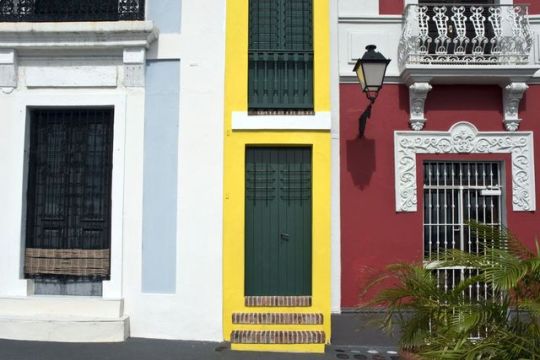
Full text write on https://easy-travel.pw/what-i-spent-five-nights-in-san-juan-puerto-rico/magazine/
What I Spent: Five Nights in San Juan, Puerto Rico
01 of 07
Upfront Costs
Dennis K. Johnson/Getty Images
The upfront costs of vacations are predictable. It’s the little things—airport snacks, cocktails before dinner, tipping a tour guide—that can throw even the most well-planned vacation budget off track. In this new series, we’ll look at the spending patterns of real travelers in popular destinations, so you can estimate what you’ll actually spend. (Thanks for the inspiration, Refinery29!)
In this installment, a couple travels to San Juan, Puerto Rico for six days of sun.
Flight: $685, round-trip from DEN to SJU (bought two months in advance)
Accommodations: Free—we stayed with my brother’s colleague and his wife in their beachside condo. We had an overnight layover on the way home, though: $99 for a room at the Wingate by Wyndham Charlotte Airport South/I-77 Tyvola, which offers a free shuttle service to and from the airport.
Baggage fees: My boyfriend and I shared a large duffel to save some money (plus I’m a serial overpacker). Cost: $50 ($25 each way)
Size of Group: 4
Continue to 2 of 7 below.
02 of 07
Wednesday to Thursday
Maremagnum/Getty Images
4:15 p.m. Our Uber arrives. We all have TSA Pre-Check, but we’re heading to the airport early to squeeze in dinner before our 7 p.m. flight. My brother picks up the ride. Cost: $100 for Global Entry, which includes TSA Pre-Check (valid for five years)
4:40 p.m. The drive is quick, but the line to drop off checked bags is snaking through the concourse. We head outside to check it curbside, which saves us a lot of time. Cost: $2 tip
5:15 p.m. What’s a vacation without a little indulgence? We grab a table at Elway’s, a Colorado steak house, and cheers to forgetting about work for a week (a vodka-Sprite for me). I order the steak tacos, which are in the appetizer section but entrée-sized. Cost: $33
7:07 p.m. We’re finally on our way—to Houston, where we have a layover.
12:25 a.m. (next day) Our one-hour layover has turned into two, and almost nothing is open in the airport so my boyfriend and I wander bleary-eyed around the terminal until we’re finally able to board.
7 a.m. We grab our duffel from baggage claim and head outside to meet my brother’s colleague. He arranged for a van to pick us up and take us to his home. Cost: $0
8:01 a.m. We unpack our bags and then beeline to the patio to take in the views of Condado Beach. We’re anxious to feel the sand under our feet, but our hosts have graciously cooked breakfast for us so we fuel up with scrambled eggs and ham, fresh fruit (some of the juiciest mango, papaya, and pineapple I’ve ever tasted), and apple-filled pastries from a nearby bakery.
10:30 a.m. You always forget something when you go on a trip, and this vacation was no exception. We walk two blocks to CVS for a couple bottles of sunscreen. I pay. Cost: $19.26
11:18 a.m. We nab four lounge chairs on the sand in front of the San Juan Marriott Resort & Stellaris Casino. (Our hosts are members of the hotel’s Ocean Club Wellness Center Spa, which gives us access to the venue’s amenities as well.) A server from the resort’s La Isla Beach Bar and Grill walks over and takes our order for Miami Vices. My brother’s girlfriend picks up the tab. Cost: $0
2:09 p.m. In need of a break from the sun, we wander to Ashford Avenue, the main drag in the Condado area. After peeking into a number of fairly empty restaurants, we end up at Pannes. Here we get our first taste of local (read: the Coors of Puerto Rico) lagers—Magna and Medalla Light—and cuisine. Mofongo is a dense ball of mashed green plantains, typically stuffed with a protein. I order mine with chicken in tomato sauce; it’s dense and comforting—and definitely not the first choice when you’re wearing a bikini. Cost: $17
3 p.m. We walk the few blocks back to our condo to take a nap, shower, and get ready for dinner.
6:20 p.m. The four of us hop in an already-paid-for shuttle with our hosts. Our destination: Old San Juan, one of the oldest cities in the United States. Cost: $0
6:48 p.m. The cabbie drops us near the entrance to El Morro, which the Spanish built in the 16th century to protect the San Juan Bay from attacks (including by pirates). We take in the sight and then wander down the area’s sloping, blue-cobblestone streets, passing colorful buildings and fellow tourists seeking cocktails and dinner.
7:07 p.m. Carli’s Fine Bistro & Piano is packed when we enter, but thankfully we already have reservations. The restaurant is owned by pianist Carli Muñoz, who spent 11 years touring with the Beach Boys. He treats us to a short stint at the piano as we sip our drinks (a Mojito for me). I order the night’s special: churrasco (skirt steak) with roasted potatoes and sautéed vegetables. Cost: $40
9:45 p.m. The shuttle picks us back up and takes us home. After sleeping fitfully on the plane and today’s short nap, I’m excited to get to bed early. Cost: $0
Continue to 3 of 7 below.
03 of 07
Friday
Atlantide Phototravel/Getty Images
9:45 a.m. We awake to the smell of pancakes. Eager to get in the water, we eat quickly. My brother and his girlfriend, up before my boyfriend and I, decide to take a walk down Ashford Avenue. They meet us at the beach an hour later with a six-pack of Medalla beer—and a tip. The liquor store is way overpriced; in the future, we should buy our alcohol at CVS. We manage to hold off popping open a can until about 11:30 a.m. Cost: $0
1 p.m. The current at Condado Beach is strong, the breaking waves pretty relentless. Between the sun and the workout we get from diving beneath them, we’re starving. Our hosts want to give us a taste of traditional Puerto Rican cuisine, so they treat us to a homemade lunch of fried plantains, roasted chicken, rice, and red beans. Cost: $0
4:30 p.m. After a couple more hours of beach lounging, we pack up for our evening excursion. We know we won’t really have a chance to eat dinner, so we head across the street to the small natural grocer to pick up some snacks—protein bars and plantain chips—for the bus ride. We spot the largest avocados any of us has ever seen; they’re the size of cantaloupes! Cost: $12.50
5:15 p.m. Our meeting point is the tour desk at the Marriott. From here, we load onto a small bus for the hourlong drive east to Fajardo (with a short stop to pick up more passengers), where we’ll set off on the Glowing Bay Adventure to Laguna Grande with Island Kayaking Adventures. Cost: $100 per person, including transportation
7 p.m. We arrive in Fajardo with 30 minutes to use the public bathroom (which costs 50 cents), apply bug spray, and grab a small bite to eat from one of the nearby food stalls. We opt for hot-out-of-the-fryer carne empanadas from Delicias Criollas Dorcas. Cost: $4.50
7:30 p.m. After a brief safety presentation, my boyfriend and I load into our shared kayak and our group sets off into the lagoon. The new moon is barely visible, which makes our journey through the mangrove channel all the more thrilling. Twenty-or-so minutes later, the landscape opens up and we are officially in the bay. We sweep our hands through the water and watch the dinoflagellates sparkle in response. Too soon, we direct our kayaks back toward the mangroves and our ride home.
11:15 p.m. The bus drops us at the Marriott. I’m too tired to eat, but my boyfriend and brother grab burgers to-go from Buns Burger Shop. Cost: $0
Continue to 4 of 7 below.
04 of 07
Saturday
Michele Falzone/Getty Images
7:40 a.m. After a late night, this early wake-up call is rough. My boyfriend and I head to the small café inside the Marriott for a grab-and-go breakfast. I pay. Cost: $12.52
8 a.m. We load onto the bus that will take us to El Yunque National Forest, the only rainforest in the U.S. national forest system. Cost: $69 per person, plus a $20 tip for our guide (we split the tip by couple)
9:20 a.m. Short pit stop to watch the park’s welcome video (narrated by native Puerto Rican Benicio del Toro) and hit the bathrooms.
11 a.m. A one-mile “hike” along a stone path through the forest leads us to La Mina Falls. We strip off our sneakers and step delicately into the frigid water, clambering over rocks to reach the rushing water. I stay under the falls just long enough for a photo-op (thank you, waterproof camera).
11:56 a.m. On the walk back to the bus, we stop to pose for pictures in front of a towering, moss-covered tree.
12:11 p.m. The final stop on our rainforest tour is the Yokahú Tower, which was built in 1962 as an observation tower. We climb the 98 steps and breathe in the fresh air and views of the cloud forest and northeast coastline.
12:45 p.m. Our guide pulls over on the side of the road at a small fritter stand run by two locals who speak zero English. Puerto Ricans call almost anything fried “fritters,” mostly to make it easy for us non-Spanish speakers. In this case, “fritters” translates to empanadas, taquitos, and papas rellenas—and nothing cost more than $2.50. Everyone chips in a few dollars. Cost: $3
5:55 p.m. After some down time at our condo, we head down Ashford Avenue to grab a drink and watch the sun set. At the Piña Loka food truck, I go full tourist and treat myself to a carved-out pineapple filled with piña colada that I then have to lug to the beach. We enjoy the view for all of 10 minutes before it starts pouring rain and we run for cover. Cost: $12
7:45 p.m. The rain forced us inside just in time to get ready for dinner. It’s New Year’s Eve and our hosts have booked us a table at one of their favorite fine dining spots: Pikayo Restaurant, inside the Condado Plaza Hilton. They pay for the short cab ride. The three-course prix fixe menu is modern but rooted in local favorites. A tequila cocktails starts the evening off, followed by salad, Alaskan king salmon in a spicy mango sauce, and a Nutella-rich dessert. Cost: $95
11:35 p.m. Shortly before midnight, the staff hands out noisemakers and NYE hats. The salsa band gets started, and much of the restaurant—including our group—gets up to dance.
1 a.m. Our hosts once again pay for our ride home. We have one more drink on the patio before calling it a night. Cost: $0
Continue to 5 of 7 below.
05 of 07
Sunday
Pamela's Caribbean Cuisine
11:32 a.m. With an early lunch planned, we enjoy a lazy morning before hopping in the car to Ocean Park Beach. We have a date with the beachfront Pamela’s Caribbean Cuisine. I slip my flip-flops off and dig my toes into the sand while perusing the menu of Caribbean-fusion eats. The group shares some superfresh grouper ceviche and calamari, and I get the churrasco wrap with chipotle-pineapple salsa for my meal. My brother treats. Cost: $0
1:05 p.m. Pamela’s guests have access to the restaurant’s beach chairs and umbrellas. Our server sets four up for us closer to the water after our hosts head home, and we let our lunch settle as we soak in the sun.
2:34 p.m. A man selling beers from a cooler wanders by. My boyfriend orders a Corona. Cost: $0 ($3 for him)
3:18 p.m. My boyfriend and I wander down to the end of the beach—past dozens of kitesurfers getting their gear ready—and meet my brother and his girlfriend at the outdoor bar connected to Hostería del Mar. It’s happy hour from 1 to 5 p.m., so my house-made sangria tastes especially sweet. Cost: $7
4:37 p.m. We’d planned to walk along the beach the entire way back to our condo, but an unpassable section forces us onto Ashford for the final few blocks.
6:40 p.m. We grab a cab at the Marriott to take us to Old San Juan for dinner. Unfortunately, many of the roads are closed due to preparation for some government events taking place the next day. And with so many people in town for the holidays, many restaurants are already booked. We detour to a nearby Ruth’s Chris Steak House (a favorite of our hosts’) instead. I order a Caesar salad and lamb chops. They pay. Cost: $0
Continue to 6 of 7 below.
06 of 07
Monday
Carla Sá Fernandes/Getty Images
7:50 a.m. Another early wake-up for our final excursion of the trip. But first, a quick breakfast to-go. Cost: $0 (cheers to Starbucks gift cards)
8:05 a.m. We hop on the bus to meet our catamaran, the Spread Eagle II (yes, really) for a day of snorkeling off the coast of Fajardo. Cost: $116 per person, plus a $20 tip for the crew (which I cover)
10 a.m. All aboard! We set sail for Icacos Island. Due to the time of year and choppy water, there’s not much to see while snorkeling (snorkels are provided by the tour company), so we hop back on the boat and enjoy our included buffet lunch before grabbing some beers (my brother’s treat), heading to shore, and wading in the shallows before taking off for our second stop. Cost: $0
2 p.m. The crew anchors off the shore of Palominos Island, the private island of El Conquistador, A Waldorf Astoria Resort. We jump into the water and swim around for 45 minutes, spotting some small, colorful fish and plenty of coral. The sail back takes about a half hour, and I nap on the bus on the ride home.
7:35 p.m. Pre-dinner drinks are a vacation necessity—especially when it’s our last night in San Juan. We pop across the street to Bar Gitano for a quick tipple before dinner. Cost: $10
8:04 p.m. Dinner is just down the block. We have reservations for Big Band Mondays at Yerba Buena Restaurant. As we sip not-too-sweet Mojitos and dig into shrimps in coconut sauce and fried whole red snapper, a dozen musicians play Puerto Rican classics. It’s the best food—and music—we’ve enjoyed the entire trip. A perfect way to wrap up our first visit to this lively city. Cost: $0 (our hosts paid)
Continue to 7 of 7 below.
07 of 07
Tuesday to Wednesday
David Madison/Getty Images
8:38 a.m. We catch a cab at the Marriott to squeeze in a few hours exploring Old San Juan before our flight home. I pay. Cost: $18
8:59 a.m. The neighborhood is quiet and many shops are closed. We start to worry we won’t find anywhere for breakfast. Then we stumble upon La Bombonera, a historic bakery that lures us in with a drool-inducing pastry window. We decide to keep it on the healthier side with cafe con leche and omelettes. We split the bill by couple, and my boyfriend covers our half. Cost: $0
9:51 a.m. We wander the narrow streets, popping into shops and stopping to look at the fort walls, ocean views, and government buildings. At the Haitian Gallery, my boyfriend and I are drawn to paintings by a local artist. We buy three small ones depicting city and nature scenes from the surrounding area. Cost: $145
12:37 p.m. We grab a cab back to the condo, which my brother pays for. Lunch is waiting for us: a tomato-y chickpea stew that our host’s wife says is her favorite local dish. We pack our suitcases and head to the beach for the final time. Cost: $0
4:30 p.m. The prepaid van taking us to the airport arrives. Cost: $20 (tip)
5:43 p.m. After having to lighten our duffel to avoid extra fees (my boyfriend and I wind up carrying all of our shoes in plastic bags), we grab an early, not-so-great dinner before our flight. Cost: $15
6:40 p.m. The airline staff give my brother and his girlfriend grief about the size of their carry-ons, so they’re forced to check them through to Denver. And then we’re finally airborne to Charlotte.
9:40 p.m. We get a ride to our accommodations from the hotel’s free shuttle.
6:29 a.m. (next day) The airport is pretty vacant. We sit down for breakfast at 1897 Market—hot tea and Greek yogurt with granola for me. My boyfriend covers our half of the tab. Cost: $0
9:21 a.m. We land in Denver. After picking up our bags, we hail an Uber. My boyfriend pays. Cost: $0
Totals
Food & Drinks: $261.02
Activities & Entertainment: $285
Transportation: $38
Accommodation: $99
Miscellaneous: $346.76
#travel #airlinetickets #airtickets #cheapairfare #planetickets #travelinsurance #travelquotes #travelblogger #traveller #travelling #travelocity #travelodge #vacation
0 notes
Text
METEORA TRAVEL GUIDE: Itinerary, Budget, Things to Do 2018
The first hermits arrived in hopes of finding seclusion and spiritual peace. Centuries later, it is still easy to see why, of all places, it is here that they chose to dwell. Even amid the the busyness of tourists like us swarming around the monasteries and gawking at the surrounding landscape, Meteora remains as serene as slumber and as solemn as a prayer.
It’s not difficult at all to be captivated by Meteora. I had my first glimpse of it through a viral Facebook video that features the monasteries perched atop lofty rocky pillars. At that moment, I knew I had to set foot in it and see it for myself. There’s this old saying immortalized in memes: If you want something badly enough, the universe will make conspire to make it happen. I’m not one to rely on the wisdom from memes, but it turned out to be true in this case. I didn’t think I’d be able to visit Meteora this soon, but a series of fortunate events led me to this.
WHAT’S COVERED IN THIS GUIDE?
The name “meteora” means “high up in the air,” referring to the towering pillars that make up this rock formation, overlooking the plains of Thessaly in Greece. Since the first hermits took shelter in its caves, these sandstone columns have seen 24 Eastern Orthodox monasteries, making it one of the faith’s most important sites, second only to Mt. Athos. Because the monasteries were built on the summit of these rocks, they offer complete isolation. For most of its history, the only way to reach them were by long ladders, ropes, and nets.
Today, only six of these monasteries remain standing. Inscribed in the UNESCO World Heritage List, Meteora has been drawing tourists from all around the world for its historical, cultural, and geological significance as well as breathtaking scenery.
Here’s more info about Meteora.
Language: Greek. However, English is widely spoken.
Currency: Euro (EUR, €). €1 = 1.14 USD, SGD 1.6, PHP 61 (as of October 2018)
Modes of Payment: Cash is still the most common.
Electricity Info: 230 V, 50 Hz. Power sockets are Type F, which also accept Type C plugs.
April to June and November, when the weather is comfortable and the crowd isn’t that big.
July to October is high season, so rates in Greece in general are higher and the site is overrun by tourists. July and August are the driest and the hottest months.
December to March is winter. It’s not just the coldest, it’s also the wettest period. It doesn’t mean though that it rains every day. We visited in December, but it didn’t rain at all, not even a slight drizzle. Maybe we just got lucky. One important thing to note when traveling in winter is that there is no public bus service to Meteora from Kalambaka or Kastraki, which limits your transportation options significantly.
There are two towns lying at the foot of the Meteora cliffs: Kalambaka and Kastraki. To get to Meteora, you need to find your way to any of these.
Most independent travelers and backpackers prefer to stay in Kalambaka, which offers more lodging, dining, and tour options than Kastraki. In Greek, the official name of the town is Kalabaka, but it is also often called Kalambaka or Kalampaka. Don’t be confused. They all refer to the same town.
Here are some of the top-rated hotels in Kalambaka and Trikala, as scored by Traveloka and Tripadvisor users.
Famissi Hotel. Photos provided by Traveloka.
Search for more Meteora Hotels
The nearest airport is Nea Aghialos National Airport (aka Volos Central Greece Airport or Volos Nea Anchialos Airport), located in Central Greece, south of Thessaly.
But most tourists come from Athens. If you’re coming from Manila or Singapore, the most cost-efficient way to reach Athens is to fly with Scoot. Scoot fares to Athens start at PHP10,403 from Cebu, PHP10,704 from Clark, PHP11,198 from Kalibo and PHP10,754 from Manila. These can still go lower when there is a promo. Look:
Actual fares we found for March
All flights from the Philippines will have a layover in Singapore. You can take this opportunity to also tour SG while you’re at it. From SG, the travel time to Athens is 11 hours and 10 minutes. Scoot uses a new Boeing 787 Dreamliner, so you can expect the cabin to be spanking clean and well-maintained.
If you want to score ATHENS PROMO FARES, keep a lookout for Scoot’s monthly Take-off Tuesday promotions, which happens every first Tuesday-Thursday of every month, available on their official website!
Athens to Meteora by Train
It’s easy to reach Meteora by train. Kalambaka has its own train station and is connected to Larissa Train Station, which is the central railway station in Athens.
Take the Metro Red Line to Larissa Station. If you’re coming from Syntagma, it should be easy because Syntagma is also along Red Line, just four stations away. Fare: €1.40. If you’re coming from Athens Airport, you must first take the Blue Line to Syntagma Station and then transfer to Red Line to Larissa Station. Fare: €10.
At Larissa Station, board the train to Kalambaka. There is only one direct train per day, scheduled to leave Athens at 08:20am and arrive in Kalambaka at 01:18pm. Fare: €18.3 – €25.6. If that’s not an option for you, you may travel to Paleofarsalos first then switch to another train bound for Kalampaka. See the schedule below.
Alight at Kalambaka Station. This is the last stop.
From Kalambaka Station, take the bus to Meteora. From March to November, there’s a bus leaving Kalambaka at 9am, 12 noon, and 3pm. Fare: €1.80 one-way, €3.30 round trip. No public buses in winter. You can either take a cab instead or just hike, which is great and very scenic.
For the train timetable, visit: Athens-Kalambaka Train Schedule.
Athens to Meteora by Bus
There are no buses that go directly to Meteora or Kalambaka. Instead you will have to travel by bus to Trikala, the city closest to Meteora, and then transfer to another bus to Kalambaka.
Make your way to LIOSION 260 BUS STATION. This is the terminal where buses bound for Trikala are stationed. It’s at 260 LIOSION STREET. – If you’re coming from other parts of the city center, you may take the metro. The nearest Metro Station is Kato Patisssia Station, which is 900 meters away. If you take the metro, make sure you have enough time allowance for walking. You can also just take a cab. – If you’re coming from the airport, board City Bus X-93 and alight at Liosion Street Bus Station. Travel time: 55 minutes.
Take the bus bound for Trikala or Kalambaka. A bus leaves at 7:00am, 10:30am, 1:30pm, 3:30pm, 6pm, and 9pm daily. An extra 5pm trip is added every Friday and Sunday. Travel time: 5 hours.
In Trikala, transfer to another bus bound for Kalambaka. There’s one every hour. Travel time: 30 minutes to 1 hour. Total fare from Athens to Kalambaka is €31.50.
From Kalambaka Station, take the bus to Meteora. From March to November, there’s a bus leaving Kalambaka at 9am, 12 noon, and 3pm. Fare: €1.80 one-way, €3.30 round trip. No public buses in winter. You can either take a cab instead or just hike, which is great and very scenic.
For the train timetable, visit: Athens-Kalambaka Train Schedule.
Monasteries Tour
Six ancient monasteries remain standing to this day, and they’re all open to visitors. From Kalambaka, you can take the bus to the monasteries. The bus will stop in all six monasteries. Here’s the bus schedule for March 16 to November 30, 2018. This may change in the coming years so make sure to call your hotel to confirm the schedule. No bus service in winter.
Fare: €1.80 one-way, €3.30 round trip.
As you can see, there are only a few buses per day, so you won’t be able to see all the monasteries if you’re relying on the bus. What most tourists do is they take the bus going up and then they just explore the place on foot, then they take the last bus back to Kalambaka. Ideally, you should be able to visit 2-3 monasteries in a day. Although it is possible to see more than 3 in a day, the pace may be too fast or stressful.
Note that these monasteries are not open all week. Each has its own closing day. We indicated the operating days and hours for summer 2018 and winter 2019 below. However, please note that these change every year and every season so double check with official sources before your trip.
Great Meteoron Monastery Summer hours: 9am-4pm (Closed: Tuesdays) Winter hours: 9am-3pm (Closed: Tue-Wed)
Varlaam Monastery Summer hours: 9am-4pm (Closed: Fridays) Winter hours: 9am-3pm (Closed: Tue & Fri)
St. Stephen’s Monastery Summer hours: 9am-1:30pm, 3:30pm-5:30pm Winter hours: 9:30am-1pm, 3pm-5pm Closed: Mondays
Roussanou Monastery Summer hours: 9am-5pm Winter hours: 9am-2pm Closed: Wednesdays
Holy Trinity Monastery Summer hours: 9am-5pm Winter hours: 9am-4pm Closed: Thursdays
St. Nikolaos Anapafsas Monastery Summer hours: 8am-4pm Winter hours: 9am-4pm Closed: Fridays
All monasteries above charge a €3 entrance fee. Kids 12 and below can enter for free.
These monasteries offer not just stunning views. They also house important historical artifacts. For example, the Great Meteoron Monastery also showcases the role of the Orthodox Church in key events in Greek history including World War II. St. Nikolaos Anapafsas Monastery displays frescoes created by Theophanes in 1527.
The Great Meteoron Monastery and the Varlaam Monastery are the biggest and the two most popular. St. Stephen’s Monastery and Roussanou Monastery are the easiest to access.
You can do it on your own, but because of the site’s immense historical importance, joining a guided tour will make your trip not just enjoyable but also enlightening.
Half-day tours usually cost €25 to €35.
Great Saint Scrambling Tour
The Great Saint Rock is one of the most iconic in Meteora. If you’re up for an adventure and you’re in great shape, this is right up your alley. This is a guided tour that will lead you to the tallest rock in the area, around 400 meters above the ground. There will be some climbing, abseiling, traversing, and lots of hiking, so be prepared physically and mentally.
You MUST have a guide to be able to do this because it’s a bit dangerous. Tours start at €60.
Church of the Assumption of the Virgin Mary
Built in 7th century AD, this is one of the oldest churches in Greece. This Byzantine church is often overlooked by tourists even though it’s centuries older than the monasteries perched on the Meteora rocks. It has three aisles and features frescoes that can be traced back to as far as 14th century. Don’t miss the relics of an older Green temple can also be found inside.
If you’re staying in Kalambaka, you can easily make your way to this church.
Kastraki Village
Kastraki is one of the two villages at the foot of Meteora. Although Kalambaka harbors more hotels, restaurants, and tour agencies, Kastraki is quieter and more picturesque. Even if you’re staying in Kalambaka, Kastraki is worth a stop too. The village lies in between two colossal rocks, ensuring an unforgettable view from the base. The 19th-century houses along its streets are well-preserved, too!
Here’s a sample overnight Meteora itinerary. It assumes you’re arriving in Kalambaka before 2pm. We’ve indicated the entrance fees if you want to explore on your own as well as the usual tour rates if you want to join a guided tour.
DAY 1 – SUNSET TOUR
Arrival in Kalambaka
Hotel check-in
Meteora Sunset Tour: €30
St. Stephen Monastery. Entrance fee: €3
Dinner in Kalambaka
DAY 2 – MONASTERIES TOUR
Early check out
Sightseeing Tour: €30
Great Meteoron Monastery: €3
Varlaam Monastery: €3
Roussanou Monastery: €3
Lunch
Departure
If you’re exploring Meteora DIY-style and on foot, Meteora is going to be one of the cheapest trips you’ll have in Greece. But if you’re joining guided tours, prepare to shell out around €100 for the tour fees, entrance fees, and gratuities.
Is Meteora safe?
When it comes to crimes, yes, Kalambaka and Meteora are very safe generally. But as in other places, follow the rules and don’t leave your things unattended.
If you’re not physically fit, don’t join some of the hiking tours, especially the Great Saint Scramble. It is a physically demanding activity.
Because of the rugged terrain and lofty cliffs, there’s always danger especially when it rains, so be extra careful. Don’t go too close to the edge. Wear shoes that have a good grip.
Should I explore Meteora on my own or should I join a guided tour?
It is possible to explore Meteora on your own. As mentioned, from mid-March/April to November, there are buses that can take you to the monasteries. It is also accessible if you just hike. However, having a guide will make you have a better understanding of the history and significance of the place. If you’re hiking, the trail isn’t always well marked, so a guide can be a great help.
What to wear inside the monasteries? Is there a dress code?
Knees and shoulders must be covered. Men need to wear long pants (trousers) that cover the knees. Women must wear skirts that cover the knees. There are wraps and long pants that can be borrowed by the entrance.
Are there restaurants near the monasteries?
None. No restaurants or cafes. There are small stalls selling snacks nearby, but that’s about it. It’s best to bring your own water and easy-to-eat food.
What is tipping policy in Kalambaka?
Tipping is NOT mandatory or expected in Santorini. You can just round up the bill. If your bill is €23.5, they usually just pay €25. But if you’re very happy with the service, 10% of the bill should be fine.
Do I need a visa to visit Greece?
Greece is part of the Schengen Agreement. For short visits, a Schengen Visa is required for most nationalities except for nationals of 62 specified countries which include Singapore, Malaysia, and the United States.
If you’re a Philippine passport holder, you will need a Schengen visa. We have a separate post discussing the visa application process in detail.
Read: Schengen Visa via Greek Embassy
[embedded content]
Source: https://bloghyped.com/meteora-travel-guide-itinerary-budget-things-to-do-2018/
0 notes
Text
Best Tour Guide of Beijing Holiday
20110505 – Greatest Tour Guide of Beijing Holiday
The very best tour guide we’ve had anywhere in the world without her help we would not have seen the things or done the things we did.
We’d certainly recommend your organization to anybody visiting Beijing.
Ron REARDON 2011-05-05
Travel advisor with this tour
My name is May Wei, a local man of Beijing. I am working at Beijing Holiday as a travel adviser. Before that, I’ve got years of operating experience on different field like tourism, education, international trade, publishing business, etc..
Frequently asked questions and Replies
Hi, I am seeing beijing for almost 12 days…. And that I would prefer a complete tour guide and hotel pickup… and the places where we’ll be seeing along with the resort’s there too… we all are looking for sight seeing, adventure and shopping… would like to remain in hotel apartments too for 2 ppl…. Would like to know how long it takes to have the visa prepared.
Dear Zahra, decent day to youWe can organize an in-depth Beijing excursion package totally based on your interests and requirements. We can assist with your Chinese visa program, and supply all the necessary reservation records that you submit to your visa application. We will focus on the comprehensive itinerary with estimated price and ship it to you within a day. Thank you very
Mrs.Amrita (India) requested:
My husband and myself are now travelling by Air China from Mumbai to Honolulu through Beijing on Dec 28. We have a 14 hour transit (arrive at 10:50am on Dec 28 and leave at 01.50am on Dec 29). On our way back Jan 9 from Honolulu, we again have a 14 hour transit in Beijing where we arrive at 05.20am on Jan 9 along with also our connecting flight is at 19:40pm Jan 9. Because of our long haul period, we were curious to do some sightseeing in Beijing. A few questions pertaining to the above: 1 ). Is your free visa applicable during our travel both ways and what’s the process? 2. Can you give us undependable one day sight seeing options with prices that include pickup and drop to Airport. We’d like to pay as far as possible from: Badaling Great Wall, Tiananmen square, Forbidden square, Summer palace, Temple of Heaven, Hutong tour, visit a kung fu series, have local lunches and pay some shopping areas!! 3. What is the mode of payment?
Thank you very much for allowing me your journey program.
Yes, it’s applicable for a visa free excursion during your layover. I have sent an email with the comprehensive process and estimated itinerary together with tour cost. Please check the facts at your convenience.
HiI will transit at the Beijing airport and remain there from 3pm to 1am. I am interested a tour of the Badaling Great Wall and Forbidden City. Could I really have a half day excursion to go to both of these areas? How much would this cost? Is it ok to do so as a solo traveler? Thank you.
I am terrified that you may have the ability to see only one place, possibly Badaling Great Wall or the Forbidden City, since the tourist sites usually are closed at 18:00 during the summit and at 17:00 during the off season. There’s absolutely no problem to journey as a solo traveler. I shall definitely email you the details after today. Thank you very much.
Stephen g** (Singapore) requested:
Hello do I require a visa to See China, I remain for seven nights in Nov 2015 thank-you Stephen
It’s true, you do need to make an application for a visa to visit China, and we could supply you the documents that will assist you apply for the Chinese visa. I have sent an email with a proposed 7 days ahead and estimated price when vacationing at Nov.2015.
Tell us your Travel Plan or Request a Question
Travel Year
Clients’ Country
Travel Advisors
Get a Quick Questions?
from network 8 http://www.jewishtoursistanbul.com/best-tour-guide-of-beijing-holiday/
0 notes
Text
Disclosure: I was a guest of the Qatar Tourism Authority, but all opinions and recommendations are my own. This post also contains affiliate links.
Before I jump right in and start rambling about all the best things to do in Doha, Qatar, I thought I’d offer a little introduction to the country. While soccer fans know it as the host for the 2022 World Cup and frequent travelers are familiar with its impressive airport, there’s so much more to Qatar than meets the eye. Despite its small size (4,486 mi²), it’s actually the richest country in the world. And with 2.5 million people (but only half a million Qataris), it’s a multicultural destination that exceeds expectations at every turn.
While its small size means you have zoom in on Google Maps to see it, it also signifies that you can see a fair amount of the country in a short period of time. I’ve written an extensive guide to the best things to do in Qatar to help you make the best of your time there: whether it’s for a long layover, a few days, or two weeks.
Is Qatar Safe?
I always feel like I need to address this anytime I write about the Arab world because you know, the media sucks. The reality is that Qatar is one of the safest countries in the world. As in, many people don’t lock their front doors safe. Crime is virtually unheard of and as a woman, I would have no qualms about traveling here solo. So throw whatever stereotypes you have about The Middle East out the window and come visit for yourself.
One Day in Doha
The Doha Stopover Program
If you’re looking for what to do in Doha for a day, chances are that you have a layover in Doha because you’re flying Qatar Airways to your final destination. Although I personally think it’s a shame to spend just one day in Qatar, Qatar Airways has made it easy to get a taste of the city thanks to its Stopover Program. If you have more than 12 hours in Doha, you can enjoy a free night in one of Qatar Airways’ 5 star partner hotels. Alternatively, if you’d like to extend your stay to two nights, you pay just $100 for two nights at a luxury hotel. *Starts searching for an excuse to fly Qatar Airways.* Americans (along with nationals from 79 other countries) get visa-free entry to Qatar, so you really have no excuse not to take advantage of this. Who doesn’t like free stuff? All the FAQs about the program can be found here.
Okay, back to the itinerary. You can always book a city tour or desert experience through Qatar Airways, but I’m a fan of doing things independently, which is really easy to do in the city. Once you’re checked in, grab an Uber or taxi and start exploring!
The Imam Abdul Wahaab Shaikh Mosque
Start your day with a visit to the impressive Imam Abdul Wahaab Shaikh Mosque, one of the largest mosques in Qatar. The architecture and design here is truly a work of art – understated with spectacular attention to detail. It is open to non-Muslims as long as it isn’t prayer time. Women are helped into abayas at the women’s entrance and men are expected to show up dressing appropriately (covering knees and shoulders). It has over 90 domes and can accommodate 30,000 people, so prepare to be impressed.
Msheireb Museums
Although you would never guess by the way the country looks now, Qatar was once a desolate desert with an economy fueled by pearl fishing. I learned this and much more at the Msheireb Museums, located in Doha’s old cultural capital. This collection of museums, comprising of four different buildings, showcase not just the history of Qatar and Doha, but also family and cultural life and architectural innovation and development. However, my favorite building is Bin Jelmood House, focused entirely on the historical and modern day slave trade. The museum doesn’t shy away from addressing the role various countries (including Qatar) have played and continue to play in both historical and modern slavery. This topic is so easily glossed over in the United States and I really appreciate how Qatar addresses it directly. This is by far one of the best history and cultural museums I’ve been to worldwide and is truly not to be missed during a visit to Doha. Admission is free.
Museum of Islamic Art (MIA)
Inspiring design at every corner. Qatar is truly a work of art. #visitqatar #ourqatar @visitqatar
A post shared by Sally • Food & Travel Writer (@passportandplates) on Apr 13, 2018 at 8:58am PDT
Located on the Doha Corniche, the Museum of Islamic Art is home to the largest collection of Islamic art in the world. Designed by IM Pei (the architect behind The Louvre), the museum has seriously impressive and beautiful art pieces from three continents: everything from pottery to jewelry to weapons. Even the building itself is a postmodern work of art, with the top curved windows shaped like a woman’s eyes, fondly known as “the eyes of Doha.” Gorgeous plazas flank either side of the museum, boasting some spectacular views of the Doha skyline. And of course, just outside, the MIA Park has plenty of green space for relaxing and people watching, plus a café to boot. If you’re hungry, grab lunch inside at IDAM, Alain Ducasse’s first restaurant in the Middle East. Have I sold you on this place yet? Oh yeah – admission is free here too.
Dhow Cruise
After a bustling day exploring the city, relax with a sunset cruise around the waterfront in a dhow, a traditional wooden boat. You’ll get spectacular views of the Doha skyline, the Museum of Islamic Arts, The Pearl, and Al Safiya Island. After an hour of cruising, enjoy a leisurely, guided walk along the scenic Corniche before your final stop of the day. Note: if you’d prefer to book a combined walking and cruise tour (transfers included), check out this one. Otherwise, head to the Marina and negotiate prices with one of the many merchants.
Souq Waqif
Easily my favorite spot in Doha, the Souq Waqif pays homage to the traditional marketplaces of the country from the pearl-diving days. Despite being renovated in 2006 after a fire, it still retains authentic Qatari architecture and is the best place to shop for souvenirs. You could easily spend hours and hours exploring the Souq – luckily, it doesn’t close until 10 pm. While I recommend wandering around and taking in all the sights and smells, be sure not to miss any of the main attractions listed below. Grab a map from the Souq Waqif Information & Tourism Center and go!
The Falcon Souq: Falconry is a traditional Qatari sport still practiced today, and these majestic birds retail for thousands of dollars. In the falcon area of the market, be sure to visit the shop dedicated to selling all things related to the birds (including falcons themselves). You can even get a photo of yourself holding one. If you’re even more curious, stop by the nearby Falcon Hospital and check out the falcon waiting room and pharmacy. It’s fascinating!
The Gold Souq: Ornate jewelry, anyone? The section of the souq dedicated to gold is almost as beautiful as the gold itself. Here you’ll find a wide variety of stunning pieces, although you’ll likely be more tempted to just window shop in this area.
The Bird Souq: Falcons aren’t the only bird species that Qataris purchase. You’ll hear the bird souq before you see it, thanks to the incredible and slightly overwhelming number of species available for sale.
The Horse Stables: For a bit of calm away from the chaos of the central souq, head over to The Horse Stables and bid your salams to the horses used by the souq’s heritage police (aka security). Don’t worry though, visitors are encouraged.
The Camel Pen: If you haven’t quite gotten your fill of animals, scope out the camel pen to watch the camels enjoy their evening meal.
Local Art: The Souq Waqif Art Center showcases works by both local and international artists. You’ll find everything from Islamic Calligraphy to photography to paintings.
The Shops: If you’re looking to purchase souvenirs from Qatar, Souq Waqif is the place to do it! You’ll find a large collection of your typical souvenirs like magnets and trinkets, but you can also purchase traditional Qatari goods. Qatar is known for Oud, a strong incense sold in both perfume and wood form that is a favorite amongst locals. Spices are also a popular gift, along with clothing, dates, and more.
The Food: Souq Waqif is home to an impressively large collection of restaurants, both Qatari and otherwise. Whether you’re here for a snack, a meal, or a coffee stop, there are plenty of drinks and bites to satisfy your craving.
Eat dinner at The Souq Waqif. Qatari traditional food is surprisingly hard to come by, especially due to the large influence of international flavors in the country. However, if you’re looking to try some local dishes, stop by either Al Jasra Traditional Food or Shay al Shomoos for a taste of balaleet (sweetened noodles topped with egg) or makboos (spiced rice topped with protein). If international cuisine is what you’re after, don’t miss the heavenly Iranian eats found at Parisa, the Persian restaurant that is as sparkly as it is delicious.
If you only have one day in Doha, this is by far the best way to get an introduction to the city (and hopefully, encourage you to return of a longer visit). If you’re in the city for a few more days, keep reading for more things to do in Doha.
Two Days in Doha
While there are plenty of things to see in Doha, on your second day, you’ll experience what to do in Qatar outside of the city center. Be prepared to spend at least a few hours in the car today. The earlier you start, the better.
Khor Al Adaid (Inland Sea), Dune Bashing and Camel Rides
"Once you get into the desert, there's no going back. And when you can't go back, you have to worry only about the best way of moving forward.” – The Alchemist #visitqatar #ourqatar @visitqatar
A post shared by Sally • Food & Travel Writer (@passportandplates) on Apr 8, 2018 at 8:44am PDT
This is the day in the Qatar itinerary that you can’t do independently, since you’ll need a 4×4, so book a half-day, full-day, or overnight tour for a desert adventure. After an hour or so drive, you’ll arrive at the entrance to the desert, where you can do an optional camel ride while your driver removes air from the car tires in preparation for dune bashing. Dune bashing is exactly the exhilarating adventure it sounds like – sliding down desert dunes sideways in a car. It takes anywhere from 30 – 45 minutes to arrive at Khor Al Adaid, the sea where Qatar meets Saudi Arabia (you can actually see Saudi from the shoreline). It’s also a beautiful place to dip your toes in or swim, if you so choose. Depending on your choice of tour, you will either return to Doha after a stop for some refreshments or continue on to lunch.
Note: If you choose the half-day tour, you’ll likely arrive back to your hotel around 2pm. If so, you can easily choose to do one of the activities listed in the “extra time in Doha” section.
Regency Sealine Camp (Overnight)
If you are participating in the Doha Layover program, then it doesn’t make sense to camp overnight. But if you aren’t, and you’d like a taste of glamping, then Regency Sealine Camp is for you. While the above-mentioned overnight tour takes place at a typical Bedouin camp, Regency Sealine is for those who want both the beach resort and camping experience rolled into one. You get nice beds, bathrooms, and AC, and the private beach is right outside your door. This is where you #treatyoself.
Three Days in Doha
With the exception of the Fire Station and Racing Club, the majority of suggestions on day 3 are in Education City. Although it’s not really a “tourist attraction,” I think it’s one of the best places to visit in Doha. Education City is basically utopia for students: a collection of top universities and schools in one area with impressive services to match. While this may seem like a strange addition to the Doha itinerary, it’s home to some unique cultural icons of Doha.
Doha Fire Station
Abandoned shoes and clothing by refugees in Greece – “Laundromat” by Ai Wei Wei
Not only are the contents of this contemporary art gallery fascinating, so is the building itself. Operating as a fire station until 2012 (hence, the name), it was then gifted to the father Emir, who wanted a space for cultural expression. Thus, Fire Station was born, starting as a standalone gallery and later expanding to include an artist-in-residence program. While I was there, they were hosting an amazing exhibit about the plight of refugees (“Laundromat” by Chinese artist Ai Wei Wei). Attached to the Fire Station is Café 999, a peaceful place to work, grab a drink or some food, or people watch. If you have any interest in contemporary art, be sure to check out Fire Station.
Mosque at Education City
This is by far the most unique mosque I’ve ever set eyes on (and as a Muslim, I’ve been to a lot of mosques). The design is ultra-modern, set on five pillars to represent the five pillars of Islam #symbolism. Inside, the white and pristine staircase leads up to the women’s section overlooking the men’s prayer area. There are also little skylights and windows to let natural light in. Every piece of this mosque’s design is exquisite. Definitely make a point to stop in, even it’s just for a quick peek.
Qatar National Library
I have this thing with libraries and bookstores. When I was little, I used to always tell people I would buy a bookstore if I were a millionaire. So when I found out that Doha has a beautiful new library, I knew I had to visit. If you’re anything like me, this library will feel like a playground. Not only is it absolutely stunning, but it also has a plethora of amazing resources: a heritage library with historical written collections, a 3D printer, a quiet study corner, a café, and more. It has everything you would ever need in a work / study space and is easily one of my favorite spots in the city.
Chef’s Garden
‘Chef’s Egg Benedict’ is everyone’s favorite breakfast here @chefsgardendoha . . . #goodmorning #breakfast #bestbreaksfast #egg #cagefreeeggs #organic #eggbenedict #hollandaise #drizzle #letseat #yummy #gourmet #healthy #healthymeal #organic #cagefree #fresh #foodie #dohafoodies #food #foodporn #foodgasm #photooftheday #instadaily #instabteakfast #instaegg
A post shared by Chef's Garden (@chefsgardendoha) on Jan 12, 2018 at 11:52pm PST
At this point, you’re probably eager for lunch. Although there are lots of food spots in the student recreation center, Chef’s Garden is an ideal choice for those who don’t want to relive their college days. Located inside Marwan’s Club in Al Shaqab, this café offers a selection of lunchtime bites. If the weather cooperates, I highly recommend the outdoor terrace overlooking a garden.
Oxygen Park
Oxygen Park ✨.
A post shared by 하야 🌟 (@_.hayaah) on Mar 2, 2018 at 6:12am PST
I was honestly surprised to find so many green spaces in Doha, especially considering that it’s a large city in the middle of the desert. Oxygen Park is one such space, designed to encourage people to get out and play, so to speak. One of the coolest parts is the design, with cooling tunnel segments for those running in the desert heat, recreation areas for rest and observation, and a small hill with views of Education City. It’s a fifteen-minute walk from Chef’s Garden and another aspect that makes this area of Doha a must-visit.
Qatar Racing and Equestrian Club
Now that you’ve had your fill of Education City, it’s time for some evening excitement. If you’re in Doha on a Wednesday or Thursday between November and April, don’t miss attending a race at the Qatar Racing and Equestrian Club. It’s one of the best horse training centers in the world, and admission to the races is free. I’d never been to a horse race prior to this and was fortunate to get a behind-the-scenes tour of the facility. Not only is the venue gorgeous, but the horses are incredibly well taken care of as well. Plus, the racing atmosphere is thrilling, even if you’re a dummy like me and don’t actually understand how to read the program.
Dinner
Dinner on day three in Doha depends entirely on how you’re feeling. If you’re tired and want something close by for dinner, you can eat at one of the many restaurants at the nearby Villaggio Mall. Your second option is to eat somewhere in West Bay, where the majority of the hotels are located. If you’re feeling fancy, I recommend Nobu or Sridan. And lastly, if you still have energy and want to explore a bit, head to either The Pearl or Katara Village. Both have plenty of restaurant options and are great places to walk around or have a late(r) night out. Zomato (similar to Yelp), is an excellent resource if you’re craving something specific.
Since most people only spend a few days in Doha, the above itinerary provides the highlights of what to see in Doha (and beyond) in just a few days. If you happen to be in town for longer and want a list of even more places to visit in Qatar, I got you covered. There’s no shortage of things to do in Qatar.
Extra Time in Qatar – What (Else) To do in Doha:
The Pearl
The Pearl is a man-made island that feels like one very large outdoor mall. It has great restaurants and shops, a couple of hotels, and even canals where you can take boat rides and stand up paddle board. One of the reasons it was built was to fuel foreign real estate investment in Qatar; it’s the only place non-Qataris are allowed to purchase land. The area is a tad too Vegas-like for my liking but it’s worth a visit nonetheless.
Katara Village
Katara is Doha’s culture and recreation center, home to art galleries, theaters, performance venues, and more. A lot of creative workshops and events take place here but it’s also an attractive tourist spot as well. Here you’ll find a beautiful promenade, plenty of good restaurants, and a public beach. I don’t consider it a “must-visit” as it’s more for wandering around and eating, but I’m personally a fan of the galleries and architecture here. Visit if you have some time to spare.
Al Shaqab
Run by Qatar Foundation, Al Shaqab is a state-of-the-art horse facility where Arabian show horses are trained and bred. Visitors can go behind the scenes for a tour of the facility to gain an understanding of the history and horses. As someone who knows nothing about this world, it was really interesting to see how much care and effort goes into raising horses – they even have their own spa and treadmill! If you’re interested in doing a tour at Al Shaqab, fill out the form on the website.
Aspire Park
A post shared by Таня Дубченко (@dubchenko_tanya) on May 7, 2018 at 12:33pm PDT
Aspire Park is Doha’s largest park and located 20-30 minutes outside of West Bay. It’s a beautiful green area with a lake, animals, running paths, cafes and more. They also have a ton of amazing street art and these cool trees that look like they’re pregnant. While Aspire Park isn’t a must-visit if you’re only in Doha for a short amount time, it’s definitely the best green area to spend the day outside.
Al Wakrah Souq
A post shared by محلات سوق واقف الوكرة (@wen.alwakrah.souq) on Apr 25, 2018 at 3:52pm PDT
Al Wakrah is a small but charming souq located on the Arabian Gulf about half an hour south of West Bay. There aren’t many places in Doha where you can walk around and enjoy the breeze, but at Al Wakrah you can. It also has some restaurants, shops, and cafes. Admittedly, the souq is on the emptier side in terms of shop occupants and customers but it is a nice place for a meal and a stroll.
Camel Races at Al Shahaniya
Camel love ❤️ #camel #camels #camellove #camelloversofig #qatar #doha #alshahaniya #ig_photooftheday #ig_captures #ig_today #ig_wildlife #ig_great_pics #wanderlust #goexplore #igers #posing #portrait #nature #wildlife #love #desert #desertanimals #arabian #natgeo #travel #danielcliffordphotography
A post shared by Daniel (@danielclifster) on Jan 12, 2018 at 7:17pm PST
Every Friday from November to February, you can watch camel races at the Al-Shahaniya racing track an hour north of Doha. Even if there are no races, visitors can view practice sessions at 9:30 am or 5:30 pm. And because this is The Middle East, this is where you can find the most expensive camels in the world. Note: Qatar now uses remote-controlled robots to ride camels during races rather than human jockeys because of safety. I have not found any research indicating that camel racing is cruel (except from PETA but they also want everyone to be vegetarian so I take their word with a grain of salt). However, if you are reading this and are knowledgeable about the ethics of camel racing, please share your insights.
Banana Island
A post shared by Banana Island Resort Doha (@bananaislandresort) on May 5, 2018 at 2:18am PDT
Banana Island is a luxury man-made island resort run by Anantara. It’s fancy AF, has its own private beach (naturally) and can be accessed by a ferry at Souq Waqif. While you can stay here overnight, you can also experience a day of luxury with a day pass as well. It’s actually a pretty good deal and much better than the hotel beaches within the city center.
The Malls
Can’t tell if my eyes are closed here or not but it’s the only mall photo I have so whatever.
I’m not a mall person so I didn’t spend much time in malls in Qatar. They’re a popular hangout spot, especially in the summer when it’s way too hot to even think about spending more than thirty seconds outside. If you find yourself in Qatar between May and September, chances are high that you’ll become intimately acquainted with the shopping scene.
Other Things to do In Qatar (Outside Doha):
Film City
. . Filmcity, A replica city was built in the Desert of Zakreet western part of Qatar for use in film production, it includes a large fort surrounded by palm trees. . . #Filmcityqatar . . #artsyheaven#igscglobal #nikonasia#ig_dynamic#fs_longexpo #ig_supervizor#superphoto_longexpo #kings_transports#marvelshots #kings_luxury#ig_fotografdiyari #travelanddestinations#global_hotshotz #sunset_vision#awesome_phototrip #globalcapture#amazing_longexpo #loves_longexposure#liveqatar #igrefined#fs_sunset#ptk_sky #loves_united_team#igglobalclubhdr #ig_shotz_le#loves_united_asia #bestcaptureglobal#ir_ig #iggloballife
A post shared by Salman.M (@sam_forever0) on Mar 25, 2018 at 9:26am PDT
On the West Coast of Qatar lies Film City, an entire city built as a film set for an Arabic TV show. It neighbors Mystery Village, also built for the same show, but both places are located in the real city of Zekreet. While nobody actually lives here, it depicts what a traditional village from the past may have looked like. The surrounding landscape is quite picturesque with unique rock formations shaped by the wind and if you’re lucky, you can even spot some Oryx grazing nearby. You will need a 4×4 to visit so best to either book a tour or make some local friends with cars. More information about visiting can be found here.
Ras Abrouq Rock Formations
A post shared by Aurélien (@voyageway) on Dec 17, 2017 at 3:31am PST
Similar to those found in the White Desert in Egypt, the Ras Abrouq formations are limestone structures that have been sculpted by the sand and wind over thousands of years. The Zekreet Peninsula where the formations are located is a popular place to swim and can easily be combined with a visit to Film City and the East/West West/East sculpture on a day trip. If you’ve never seen limestone formations before, I highly recommend making a point to come here; they’re truly out of this world.
East/West West/East Sculptures
"East-west / West-east" by Richard Serra, 2014, Qatar Sculpture / Installation of four steel monoliths perpendicular to the ground, in Qatar’s desert. The monoliths rusts, changes from gray to orange and finally a dark amber. This impressive sculpture in the "Brouq nature reserve" stretches for more than a kilometer and consists of four steel plates, each more than 14 meters high. To guarantee a perfect alignment, Serra examined the topography of the terrain and managed to beautifully enhance the vast solitary space, in the heart of the desert. The result is spectacular, modern, timeless. #Sculpture #Installation #Structures #Steel #SteelPlates #Monoliths #Desert #NatureReserve #BrouqNatureReserve #Qatar #Art #ContemporaryArt #ModernArt #Metalwork #BNW #BW #BlackAndWhite #PhotoBW #Conceptual #Monochrome #Monocromo #Minimal #Minimalism #Minimalistics #Monochromatic #PhotoOfTheDay #Photography #RichardSerra
A post shared by Ego Encriptado (@ego_encriptado) on Apr 23, 2018 at 11:05am PDT
Richard Serra, the minimalist sculptor and artist was commissioned to create a piece in Qatar and thus, the East/West West/East sculptures were born. Consisting of four fourteen-meter-high steel plates, it spans the greatest area of any of his pieces. This area is only accessible by a 4×4.
Al Thakira Mangroves
my life is meant for outdoors 🏄🏞🏕 #kayaks#kayaklife#kayaking#kayakadventures#watertherapy#riverlife#canoeing#canoelife#beaches#beachday#beachtime#onthebeach#
A post shared by Rhi – travel and food (@rhi_travelandfood) on Dec 29, 2016 at 10:50pm PST
Drive an hour north of Doha and you’ll find the beautiful Al Thakira Mangroves. Mangroves are trees that thrive in hot and muddy conditions and the ones in Qatar are home to a host of vegetation and wildlife. The best way to explore this lush area is by kayak, which can be booked either independently or in combination with a visit to Al Zubarah Fort here.
Al Zubarah Fort
#fort #alzubarah #qatar #desert
A post shared by ko7li (@el_ko7li) on May 6, 2018 at 2:01pm PDT
Once a thriving trade center and pearl fishing port, Al Zubarah is Qatar’s first UNESCO World Heritage site. It is one of the best-preserved examples of an 18th-19th century merchant town in the region and showcases how towns were developed based on the interconnectivity between sand and sea. Al Zubarah is located on the Northwest coast of Qatar and you can take a bus there (Route 100 from Al Ghanim Bus Station) but I personally feel like it’s best combined with Al Thakira since both are half-day experiences.
Dahl Al Misfir Cave
A post shared by Mark Peterson (@mmars_barr) on Feb 17, 2018 at 9:19pm PST
Just 45 minutes west of Doha is a forty-meter-deep cave that glows (slightly) with phosphorescent gypsum crystals. You can climb down into it and maybe see owls if you’re lucky. I don’t know if it’s worth the trek *just* to see the cave but it’s there if you want to check it out.
Transport in Doha
In 2020, Doha will be opening a metro system and it’s going to be amazing. The lines will cover transport to most places in and around Doha. Until then, your options are limited to either renting a car or taking Uber or cabs. Driving in Doha is relatively straightforward in the sense that signs are bilingual and drivers generally follow the rules of the road. However, Google Maps is hit and miss due to ever-changing construction and if you want to do any desert excursions, you’ll need a 4×4 and a local who knows the road. Therefore, until the metro opens, I recommend sticking to Uber to get around the city and organized tours for day trips.
Where to Eat in Doha
I really wanted to eat at enough restaurants that weren’t chains or hotel restaurants to write a solid list here, but I ultimately failed. With the exception of balaleet, makboos, and Om Ali, Qatari cuisine is basically international fusion. Balaleet and makboos can be eaten at either Al Jasra Traditional Food or Shay al Shomoos and the best Om Ali (think Arab bread pudding) can be found at Al Hubara at The Sheraton Grand.
In Qatar you can easily find a large variety of international food and chains. Some of my favorite places to eat were Parisa (Souq Waqif), Nobu (The Four Seasons), Al Mourjan (West Bay), and Sridan (The Shangri-La). Zomato is a great local resource for finding good eats.
Where to Stay in Doha
Many well-known hotel chains have properties along West Bay, the heart of Doha. Due to its central location, it’s my pick for the best neighborhood to stay in Doha. I stayed at the Sheraton Grand Doha, which was actually the first five star hotel in the country. The views and rooms were amazing, the service and amenities were exquisite and the food was delicious. Plus, it has its own beach and pool. I highly recommend it.
My hotel was shaped like a pyramid and had its own beach in the middle of the desert. Unexpected but that's the word that summarizes Qatar. #visitqatar #ourqatar @visitqatar
A post shared by Sally • Food & Travel Writer (@passportandplates) on Apr 1, 2018 at 8:40am PDT
If big chains aren’t your style, then it doesn’t get more boutique than the collection of boutique hotels at Souq Waqif. We toured a bunch of them and each is more beautiful than the last. What’s more, you can use the amenities from the different hotels (spa, pool, etc) so you can get the full luxury experience.
Check out more hotel options in Doha below! Booking.com (function(d, sc, u) { var s = d.createElement(sc), p = d.getElementsByTagName(sc)[0]; s.type = 'text/javascript'; s.async = true; s.src = u + '?v=' + (+new Date()); p.parentNode.insertBefore(s,p); })(document, 'script', '//aff.bstatic.com/static/affiliate_base/js/flexiproduct.js');
Qatar Packing List and What to Wear in Qatar
Qatar, although home to lots of expats, is still a pretty conservative country. While you don’t have to wear a headscarf or abaya, you should still dress conservatively to respect the culture. For both men and women, that means covering up until your shoulders and knees at least. T-shirts and pants and/or long skirts are preferred. Below are some items that I recommend.
Blouses
Loose pants
Dresses
Cardigan
Long skirt
Scarf
Large hat
Sunblock
Water bottle
Comfy walking sandals
Sunglasses
And in case you’re curious, these are all my must-have travel essentials no matter where I’m going!
I wasn’t kidding when I said in the introduction that this was the ultimate guide to the best things to do in Doha and Qatar. Although many people stop in Qatar for just a few days, there are an impressive number of things to do and see. If you’re looking to just get a taste of what Qatar has to offer, the Doha Stopover program is a good choice. However, if you’d really like to explore the country, stay for a few days or even a week; you might find that there’s more to Qatar than meets the eye.
Tell me: Would you be interested in visiting Qatar? Which activity most appeals to you?
Like this post? Pin it and save it for later!
Pin it for later!
Pin it for later!
The Ultimate Guide to the Best Things to Do in Doha, Qatar: Itineraries for One, Two, or Three Days Disclosure: I was a guest of the Qatar Tourism Authority, but all opinions and recommendations are my own.
0 notes
Photo

New Post has been published on https://vacationsoup.com/uss-arizona-memorial-kauai-oahu-hawaii/
Day Trip To The USS Arizona Memorial - Kauai To Oahu - Hawaii
Visiting the USS Arizona Memorial from Kauai, you say? Yes, I didn’t realize day trip tours of the historical monument are available until something caught my eye on Facebook. Most people visit the memorial when they are on the island of Oahu. But, what if you don’t want to stay on Oahu and still want to visit the USS Arizona Memorial? You may plan a side trip on your own or let someone else plan the adventure for you. It is a long day, but the experience may well be worth it.
I visited the USS Memorial on my first trip to Hawaii in 1980. It is a powerful and moving experience. Accessible only by boat, you are taken out to the actual site of the sunken battleship in Pearl Harbor. The monument, which is built directly over the ship, marks the resting place of 1,177 sailors and Marines who died when the battleship was bombed on December 7, 1941, about 15 minutes into the Japanese attack on Pearl Harbor. Over 900 bodies could not be recovered from the ship and remain on board.
If your flight has a layover in Honolulu, you may want to book an extra night on the island and visit the monument on your own or with a local tour group. If your vacation plans do not include Oahu then booking a day tour from Kauai might be something to look into, especially if historical sites are of interest to you.
There are several companies offering this trip. I do not have personal experience with any of them so it would be best to see what they have to offer and compare their prices. Here are three that I found. Each website has more detailed information about the trip:
Pearl Harbor Visitors Bureau
$479.99 (13 hour day trip)
Includes flights, admission and expert guides. Add $10 and get a 45 minute Honolulu City Tour.
Kauai.com
$444.26 (13 hour day trip)
This off island fly away day tour to Oahu will take you on a journey through history from the site of the attack on Pearl Harbor to the signing of the Japanese surrender aboard the USS Missouri. Visit the Statue of King Kamehameha, Honolulu Hale & Missions House Museum & finally honor the heros at Punchbowl National Cemetery of the Pacific and Court of the missing.
Pearl Harbor Oahu
$413.99 (13 hour day trip)
Visit all four Pearl harbor historical sites – the USS Arizona Memorial, the Battleship Missouri, the Bowfin Submarine and the Pacific Aviation Museum.
If you choose to go to the USS Arizona Memorial on your own, here are a few important things to remember:
The visitor center is open seven days a week, from 7:00 a.m. to 5:00 p.m. It is closed on Thanksgiving, December 25, and January 1.
Visiting the USS Arizona Memorial is free, because it is an active American military cemetery. No National Park Pass is required, and no discounts are given, because there is no charge. Entrance to the Pearl Harbor Visitor Center and its museums is also free. However, visitors will need to get a free timed ticket to see the memorial.
You can go to the visitor center for walk-in tickets on the day of your visit, or you can reserve tickets on www.recreation.gov, which is the ONLY official site to reserve USS Arizona tickets.
Although the monument receives an average of 4,000-5,000 visitors per day, most are not walk-in. They are coming with prearranged reservations as part of a school group, tour group, military unit, or other group, or they have reserved individual tickets online. Walk-in tickets are first come, first serve so there may be quite a line during busy times of the year.
Reserve tickets are separate from the 1,300 walk-in tickets handed out every day. Reserve ticket availability starts at 11:00 a.m. There are no early morning tickets available to reserve, as those tickets are kept for walk-in visitors. There is a reservation limit of 12 tickets per person per day.
Arrive an hour before your ticket time to pick up your tickets, see the harbor area, and tour two museums before your program. At a minimum, arrive five to ten minutes before your program to be sure you can enter the theater. If you are not there by your program time and they are out of walk-in tickets, your seats may be given away to visitors on standby.
For more Frequently Asked Questions and Answers, go to https://www.nps.gov/valr/faqs.htm
Whether you go on your own or book a tour, consider visiting the USS Arizona Memorial when planning your next trip to the islands.
For more of my blogs or to subscribe, go to the right-hand side of this page. Mahalo!
#Hawaii#HolidayOnKauai#honupoint#kauai#Princeville#USSArizonaMemorial#VacationOnKauai#VacationSoup#whattosee
0 notes
Text
35 Ways to Get Paid While Traveling the World
In many parts of the world, you can live comfortably for very little money—substantially less than you spend in your home country.
Between cheap flights, living in hostels, or CouchSurfing, and finding ways to earn money, food, and/or accommodation while abroad, travel can be shockingly affordable, even profitable. I’ve now been to 21 countries by pursuing #1, #8, and a few others.
Without further ado, here are 35 ways to partially or entirely finance a trip abroad:
1. Teach English
I taught English in South Korea for one year through the EPIK Program and managed to pay off my student loan debt and save ~$10,000. English is, in many ways, becoming a universal language. There are job opportunities in countless locations all over the world, and often you only need to be a native speaker and/or take an online certification course (you may also need a college degree, but in some countries you don’t). Many programs will pay for your airfare and housing on top of a healthy salary. Google and Dave’s ESL Cafe are good resources to begin discovering your options.
Posing with my sixth graders in South Korea in 2014.
2. WWOOF
This is something I’ve wanted to do for a while. Through the World Wide Organization of Organic Farms (WWOOF), you can travel to many different countries and work on organic farms. Basically, you work for 4-6 hours per day in exchange for food and housing with a host family. This leaves the majority of your day open for exploring and other activities. With the necessities covered, you only need to pay for travel expenses. I have friends who “WWOOFed” for 6 months in Japan, and some friends of a friend did the same for about 6 months in South America.
3. Peace Corps
Peace Corps is another option I’ve strongly considered and may still do. Corps members make a two-year commitment to live and work in a developing country. Members work in the sectors of education, youth and community development, health, business, agriculture, environment, and HIV/AIDS, among others. In exchange, you receive a housing and living allowance, student loan assistance, a re-adjustment stipend of $7,425 upon completion, full medical and dental coverage, plus a few other things. I know the Peace Corps would be a profoundly life-changing experience.
4. Housesitting and petsitting
Watch someone’s house and/or pets for them and get a free place to say. Some people bounce around the world housesitting for years at at time.
5. Sell art in unconventional ways
My favorite rapper-artist-novelist KOOL A.D. has made thousands of dollars selling his original artwork on Instagram. Others use services/tools such as Redbubble, Teespring, Gooten, and/or Shopify to sell their art or print/sell their original artwork on t-shirts, posters, and more.
HighExistence team members Jordan Lejuwaan, Jon Brooks, and I at a festival in Amsterdam, Netherlands in 2016.
6. Bartending
One of the easiest and most popular options for travelers. I’ll never forget the island of Koh Rong, Cambodia, where all of the bartenders I talked to were just travelers who had arrived on the paradisiacal island and decided they wanted to stay a while. I have friends who’ve bartended in Australia, Cambodia, South Korea, and probably a bunch of other places.
7. Work at a Hostel or Resort
Resort positions are among the most common forms of employment that can be easily acquired by people from foreign countries. And, there are resorts all over the planet. You could potentially work as a front desk attendant, in a restaurant, or in the activity/entertainment department. You could save money, and in your downtime, experience a tropical locale.
8. Start an online business.
It’s becoming more feasible all the time to work from a remote location, and people are capitalizing on this state of affairs to become digital nomads.
Make no mistake: online business is not a get-rich-quick scheme, but there are countless people who have found a way to earn a living online through diligent effort. If you’re curious to learn more about this possibility, read this guide I wrote.
9. Become a yoga instructor
Get certified and find yoga jobs all over the world and/or start your own classes or personal training business wherever you go.
I saw many of the best sunsets of my life on the Mediterranean Sea in Durrës, Albania in 2016.
10. Become a scuba instructor
Similar to yoga, you can get a scuba certification most anywhere in the world then get positions all over the world.
11. Do something through Workaway
Workaway is like WWOOF but broader. Workaway shares opportunities around the world to volunteer a few hours per day in exchange for food and board.
12. Tutor kids online
Many companies offer the opportunity to tutor a variety of subjects from the comfort of your home. Job websites such as Craigslist and Indeed are good places to start searching for such positions.
13. HelpX
Similar to WWOOF and Workaway, HelpX offers interesting volunteering opportunities one can work in exchange for free food and accomodation.
14. Online poker
I’m hesitant to include this one because this could easily become a black hole that sucks up thousands of dollars of your hard-earned money. It’s true, however, that Texas Hold’em and other poker games are not like most gambling games. You play against other people, and skill is a huge factor.
The best poker players win substantial amounts of money over time. If you know a lot about poker, this is an option to consider, though it’s highly advisable to read a number of poker books before starting and to begin at playing at the lowest stakes. Phil Gordon’s Little Green Book: Lessons and Teachings in No Limit Texas Hold’em is a solid book to start with. I’ve most recently played online poker at Ignition Casino, though I personally have only ever lost small amounts of money pursuing this pastime.
With my lovely girlfriend Jacki in Athens, Greece in 2016.
15. Start an Etsy or eBay business
This is another path of online entrepreneurship in which many people find success. Some people create crafts or other things and sell them on Etsy. Others hunt for undervalued items at antique shops or garage sales and sell them for much more money on Etsy or eBay. Still others start businesses helping other people sell their old, unwanted stuff on eBay.
16. Become a tour guide
With little to no experience, you can get tour guide jobs in various countries worldwide. Get paid to show people amazing places.
17. Become a flight attendant
Help people have good flight experiences and see the world in the process. Layovers for flight attendants are typically only a few hours but can be as long as a week. If you take maximum advantage of your layovers, you could get out an explore countless cities in a matter of months.
18. Use credit cards very effectively
This another item that I hesitate to include, considering credit cards are very easy to misuse, and millions of people currently find themselves in credit card debt, paying ridiculous interest rates as they try to dig themselves out of proverbial quicksand. With that being said, if you’re financially savvy, you can use credit cards to earn large sums of reward points/money, and use this to finance world travel. This article/blog is a good place to start. I’ve been simply using a couple Capital One credit cards with 1-1.5% cash-back rewards for the last few years and have probably received ~$1,000+ in rewards; others hack the system to get far more.
19. Create music and sell it digitally
It’s easier than ever for anyone to start creating and selling their own music. Get a program like Fruity Loops or Ableton and start making your own electronic music, or buy a good, cheap microphone and start recording. Sell your music independently on Bandcamp or use a service like CD Baby to get your music on Spotify, Apple Music, Google Play Music, iTunes, and more. I’ve made nearly $1000 in revenue making unusual rap music purely as a passion project over the last few years.
20. Become a massage therapist
Similar to being a scuba diving or yoga instructor, people get certified and then take their skills on the road, offering a valuable service while traveling and earning enough to live on.
21. Sell timeshares
Selling people shared vacation homes can be pretty easy and profitable compared to other jobs you can work abroad. Worth looking into.
22. Work remotely
This is one of your best options. There are now millions of jobs that you can work from your computer, in your pajamas. Here’s a nice guide to the best remote job sites. Also, an incredibly useful trick is to use SearchCraigslist.com, which lets you search all of Craigslist at once. Just search for “remote,” “telecommuting,” “remote writing,” “remote social media,” etc. For more details on how to pursue this path, see this guide I wrote.
23. Fruit-picking
Fruit-picking jobs can be found worldwide and are a good option for travelers.
Athens, Greece, as seen from the top of the Acropolis, 2016.
24. Day-trading
I’ve recently begun to dabble in cryptocurrency investing. I don’t know much about stocks or investing yet, but if you’re motivated to learn, day-trading could be a great option, and in the long-run investing in low-risk stocks (index funds, mutual funds, etc.) is one of the best financial decisions you can make.
25. Work on a Cruise Ship
A few years ago, I went on an extraordinary Alaskan cruise with my family. While on the ship, I met a woman from London who encouraged me to check out working for a cruise line if I was interested in traveling abroad while earning money. She said she makes $1,800 per month, and her housing and food are completely covered. She also told me she was on a 6-month contract, so the job wasn’t an overly large commitment. Find cruise ship jobs here.
26. Be an Au Pair
When I was in Spain last summer, I met a girl who was working as an au pair for the summer. She was spending time in Germany, Italy, and Spain looking after different families’ children during the workday. She was then able to spend her evenings as she liked and travel on weekends. It seemed like a pretty sweet gig. Find au pair jobs here.
27. Voluntary Service Overseas (VSO)
VSO‘s vision is a world without poverty. VSO volunteers work in the areas of animals and natural resources, communications and fundraising, communities and social development, engineering and technical, health, business, education, and more. VSO covers the travel expenses, insurance, and day-to-day living expenses for their volunteers. Additionally, keep in mind that VSO and Peace Corps are two among many volunteer organizations around the world that will finance your travels to volunteer abroad. Don’t be afraid to do some digging and check out others.
28. Give haircuts
Another skill you can take on the road, if you possess it.
29. Create online content and monetize it
YouTube channels, podcasts, webcomics, blogs, vlogs, games, animations, video game streaming, social media, and on and on and on. The web is bursting with mountains of multimedia content, and many of the creators of this content are making good money through advertising, affiliate marketing, or accepting donations from fans through sites like Patreon.
30. Give music lessons
Yet another skill you can take on the road. You can give music lessons anywhere or play your instrument outdoors for tips.
Jacki and I in Amsterdam, 2016.
31. Be a surfing instructor
Surf’s up, dude! Surfing lessons are popular at beach destinations worldwide.
32. Travel photography
This is a classic dream of many people. Here’s what it takes.
33. Corporate work
Many of the largest companies in the world are not in your home country. Many more have offices overseas and offer exchange programs. Here’s a good list to get started thinking in this direction.
34. Work on a yacht
Yacht jobs: they’re a real thing. Join the crew of a yacht and sail the world.
35. Be creative and entrepreneurial
This is the ultimate advice when it comes to finding ways to earn or save money while traveling abroad. In truth there are countless ways you can make this work. The limiting factors are your imagination and determination. If you are dead set on making this work, you really can do it. Think outside the box, don’t take “no” for an answer, and get out there.
0 notes
Text
Laos is More
7/11
Ok fair warning, I’ve only gotten about 3.5 hours of sleep in the last 24, and most of it was on a plane, so I wanna make this fast. But I had to write about my first day in Vientiane, the capital of Laos, because it’s been killer.
My flight from Hong Kong was 3 hours, then a 6 hour layover from 12am to 6am in the Kuala Lumpur airport in Malaysia (where I’ll be back at in 5 days lawl), and then another 3 hours to Vientiane. Luckily, the KL airport is pretty nice, with trees and lounge chairs and abundant outlets. So I worked on my Malaysia film the whole time, which was solid.
I arrived in Vientiane and took a taxi to the hotel where Christina (who is a great friend of mine from Northwestern) and her group of 5 other students are staying while they take Lao language classes and Laos history classes at the nearby university. I got immediate good vibes when my cab driver, without prompting, started teaching me how to say “hello” and “thank you” in Laos (see list below). We spent most of the ride doing a vocab lesson, with various interruptions for him to point out cool spots. Vila was his name. A homie indeed.
The hotel itself is nice; a bed, hot water, A/C, a western toilet, so I can’t complain. I met up with Christina for lunch at 12, and got some fried noodles with chicken at a little restaurant down the street that reminded me a lot of Masaya, the city I stayed in in Nicaragua. All the tables and chairs were plastic, and the nylon tablecloths were covered in giant Pepsi logos. Loved it.
The rest of the day, I sat in on her Laos history class and learned about the various conquerors and movements for independence (Siam aka Thai, then French, then free but screwed by the U.S. during the Vietnam War. For more info, read this: https://www.economist.com/news/books-and-arts/21714972-how-unremitting-decade-long-bombing-campaign-affected-small-southeast-asian).
After class, which I mostly dozed off through cause jet lag, we walked to this amazing Buddhist temple called That Luang. It’s a huge golden spike with colorful, elaborate buildings all around it, all hosting shrines to the Buddha, paintings of the Buddha’s life, and amazing sculptures of dragons and gods and spirits. We walked around talking about religion and commercialization of holy places and admiring the artistry of it all.
Then we walked around an amazing food market, this enclosed tunnel with food stalls on both sides, long tables covered in skewered meat, huge bowls of sautéed veggies, intestines and rice wrapped in lotus leaves like tamales, and bubble tea in plastic bags. Other plastic bags served another function; they were attached to fans above the food, where they swung around like ghosts, keeping flies away. I got a pork bun, which made me SOOO happy because they’re my favorite food from China and I didn’t get to eat any in the airport yesterday and I thought I’d never see them again.
We actually ended up going back there for dinner, and I got a plastic bag of spicy green vegetables and some skewered spiced hardboiled eggs. We went with these two women from England, Jess and ____, who we actually met on our way out of the hotel. They were looking for English speakers, and lo and behold, we speak English. We took them to the market, chatted about Islamophobia in England and Trump in the US (of course), and then made some plans for me to meet up with them tomorrow while Stina’s in class and go to a cool park. The beauty of traveling and spontaneity.
Anyway, so far I’ve been super impressed by Stina’s Lao skills, and have felt super welcomed by all the smiling Lao people who say “hello” when we walk down the street, even if they don’t speak any other English. Sure, we have the foreigner exoticism going for us, but their genuine smiles tell me it’s also just true friendliness, and I’m psyched to explore that more tomorrow.
<3 Scaht
New Words (these are spelled how they sound in my head, not necessarily how the English spelling is supposed to be)
• Sabaidee-hello
• La kon- Be well
• Pope gon mai-see you later
• Ka lu nah-please
• Buo-no
• Kop chai-thank you
• Kawhy suh-my name is….
• Hong nam yu sai?-Where is the bathroom?
• Phuh-noodles
• Nung-one
• Song-two
• Sam-three
• Ha-five
• Hok-six
• Sip-ten
• Sao-twenty
• Poi-hundred
• Pan-thousand
7/15
The Mekong River, also known as the Nam Khong in Lao and Thai, is the world’s 12th longest river, and it winds its pretty little way through China, Myanmar, Laos, Thailand, Cambodia and Vietnam. And today we spent a glorious day riding its currents.
Christina and I signed up literally 15 minutes before this tour agency our friend on the trip told us about last night. We roped in two other guys who are part of Christina’s program in Laos as well, Russell and Devon.
We started at 8:30 am after my hostel, which I’m paying $6 a night for, made me a beautiful omelet and half a baguette, as well as fresh fruit, for breakfast. God damn. Analong, our guide, was probably about 28 or 29, and had a big smile as he greeted us. We hopped in a van with him and headed to pick up the kayaks and hit the river.
On our way, we drove on a bumpy dirt rode, clanking up and down through potholes, surrounded by steep mountains blanketed in deep green brush. Pineapple farms, rice paddies, cornfields and more lined the road, and wooden stalls every few hundred feet sold huge piles of fresh pineapple; Analong told us it was pineapple season, and judging by the amazingly sweet chunks we ate a lunch, I believe him.
We entered the river off a muddy, unmarked gravel bank, Christina and I in one kayak and Russell and Devon in the other, with Analong and our other guide Jim in a third. The sun was bright and hot, and as Analong explained safety stuff to us, I could already feel my bare toes roasting like chicken nuggets, but once we started paddling, the breeze as we sliced through the water kept me cool.
As we paddled through the greenish-brown river, we passed fishermen in long, thin wooden canoes, farmers taking a break from their riverside fields, and a bunch of other tourists, mostly in motorized canoes drive by Lao men. But the traffic wasn’t too bad, and there was no way it could take away from the peacefulness of flowing down the river, chatting sometimes, other times just looking around taking in the palm trees and thick jungle and river weeds and mountains in the distance.
After about 45 minutes, we stopped at a park called Tad Sae, where a little waterfall ran down over big mossy boulders into multiple pools. Tourists, white Asian and Lao, all were splashing around and swimming, or hiking along the shaded dirt trails around the water. In the corner, there was a big shaded pagoda where about 6 elephants stood around, wooden seats strapped to their backs for tourists to ride them. It made me sad to see, but the good news is that Analong told me a new law was passed last year that will phase out elephant riding and send all elephants to a sanctuary within the next few years. However, when I Googled this, I didn’t find anything, so it’s unclear where this info came from.
Anyway, the best part of the park was about to come my way, because as we turned down a path, a little black monkey, so fuzzy and arms as long as his body, came hopping up to us. His pupils were huge, making his whole eyes look black, and he made little chirp chirp noises as he jumped up at our feet. Then he grabbed onto Christina’s leg and yanked himself onto her outstretched arm, swinging there from his hands like it was a branch. After exploring her a bit, I put my arm out and he swung over to me.
The minute I touched him I knew I was in love. I have a very clear memory of where my monkey visions began. I don’t know if it was an actual dream or a daydream, but at some point when I was maybe six years old, I had a vivid picture in my head appear: I was an adult. I arrived home from work, and opened my front door. Down the long hallway in front of me came bounding a little fuzzy monkey, just like this one, who clambered up my leg and sat down on my shoulder, overjoyed to see me, as I was him.
So you can see why this moment was special, a culmination of over a decade of longing for something that I had damn near given up on. I named him Nam Kong, after the Nam Khong river plus King Kong. I played with him for like half an hour, watching him swing around stair railings, scamper around people’s picnic tables and just generally be adorable. He was so smart, finding a water bottle with a lemon in it and trying to open it up, and taking things right out of my hand with his. It really was amazing how many human-like qualities he had. Even though he was ultimately more interested in people with food than my heart full of love, I understand why, and I believe that our short encounter was only the beginning of my long term monkey fantasies being realized.
I love you Nam Kong. May your days be merry and bright, and may all your bananas be ripe.
<3 Scaht
Some More New Lao Words
• Tao dai?-How much?
• Saeb-good
• Saeb bo?-Is it good?
• Saeb Saeb (high pitched)-Very good
• Buo pen yong-You’re welcome/no problem
7/16
Just some quick things I learned and reflections on Laos while I sit in the Vientiane airport for 6 hours between my flight from Luang Prabang to here and my flight from here to Malaysia:
Fun Laos Facts
According to my tour guide Analong yesterday, Laos is 20 percent more expensive to live in than any other country in Southeast Asia. I don’t know all the details, but from what I learned, it seems like this is because of the high price of many goods and the high price of electricity. Laos needs to import a lot of its goods because it’s a landlocked country and has no ports, which makes them costlier. Also, Laos generates a ton of electricity from hydropower, but this doesn’t stop the energy from being very pricey; some think this is because electricity is being exported to neighboring countries to benefit the company investors, and then resold to Laos at higher prices.
Many Lao people believe the Mekong River is haunted by spirits, which made our tour guide Jim afraid to fish in it
Buddhist monks in Laos are highly respected, and one shouldn’t even get close to them or it’s considered disrespectful. You’re also supposed to sit down when they pass by you. They even get priority boarding on some airlines.
In Laos, feet are considered dirty and the head is considered holy. It’s very insulting to point your feet at someone, and you’re not supposed to touch anybody’s head
China is investing in a ton of huge projects in Laos, including a high-speed railway connecting the two countries and a bunch of fancy hotels
Reflections
People in Laos that I met, from drivers of tuk tuks (motorcycles with carts on back that act as taxis) to street food stall owners, were all very friendly. Tuk tuk drivers were almost always chatting with Christina when they saw she spoke a little Lao, and on the flipside, every shop owner who I ungracefully tried to buy things from was very patient and worked to communicate with me, whether that was through improvised hand signals or calling over their kids or friends who spoke some English.
As a communist country, Laos made me more curious about how their system works, and how much it’s stuck to the ideals of communism that many revolutions, such as the one here, based their ideologies on. Gotta learn some more.
After visiting so many beautiful Buddhist temples, or wat, I feel really ignorant about Buddhism as a religion, and I definitely want to learn more. Gotta break out of those Judeo-Christian boundaries.
I am SOOOO thankful to Christina for hosting me here and bringing me along on her adventures. Even though she’s only 3 weeks in and is still learning so much herself, she took me to all the coolest places she’d seen, and even better, she was so down to just wander together and discover new things. Plus I feel like we got to dive deep into conversations about each other, and I learned so much about her, which is a lot harder to do when school and work and everything prevents you from just spending time with people. I’m so excited to read her blog and see how her first long-term study abroad experience shifts and shapes her.
When we were kayaking yesterday, I told her I thought we had good boating chemistry cause we hadn’t had any issue the whole time coordinating our paddles. I’ma take that a step further and say we have good chemistry period. Christina and I have been through a lot together, but just like my trip with Ben, experiencing this whole new place with her felt really special, and I can’t wait to do it again sometime.
Kop chai lai lai, Christina and Laos. Pop gun mai.
<3 Scaht
0 notes
Text
The Road So Far
Last day in Iceland (18.7) I went to the Blue lagoon. Crazy expensive but worth it if you have the money, book ahead, especially if you have an awkward layover & can’t do anything else. It feels like a million years ago! My flight was at 545 am 19th so I stayed at a hostel near the airport. Alas, this meant no karaoke in reykjavik.
Slept fitfully on way to Berlin, arrived and did some prep for my Greece volunteer program, and then napped. Ate at the hostel restau then took am early night. Or watched sense8. I can’t remember. Planned to do an art tour of Berlin on the 20th but chose to sleep in instead. Went to get coffee and brekkie nearby then showered and did my laundry. Ate my leftovers for dinner then joined an “alternative” pub crawl - more local, less binge drinking. I met a couple cool Finnish folks and one from the states. We had a fun time trying different things together. Our Aussie guide was cool too. I also successfully was turned away from my first exclusive Berlin nightclub, Berghain. Apparently I got there too late, and it was invite only at that point, but that could have just been a line. Who knows. I tried!
Next day I meant to get up for the city walking tour, but, you guessed it, chose to sleep in. I checked out, went to a nearby health food place and had a delish veggie burger & sweet pot fries. Napped – I was so tired! – then went to the airport for my flight. Arrived in Thessaloniki around 1 am, checked in to my hotel, and slept like a mf. My queen bed hotel room, btw, cost less than my 12 person dorm in reykjavik, just for comparison. Slept in next day, ventured out for dinner, and did a free walking tour of the city. Realized on my way home I was right behind two people from the tour, so I ended up going to a bar and hanging out w them for a little bit. Didn’t realize until after we connected that they were celebrating their graduation – from high school. Oy. They were cool and all but I defo felt awkward abt the age difference in this context. Went back to hotel, watched some tv, and slept. Today I slept in, got breakfast and coffee, and hopped a bus to the chalkidiki peninsula, to a town called Kalamitsi. I’m staying at a campsite here with its own private beach. It’s very hot and buggy so far but I suspect I’ll get used to it - I’ve only been here a few hours. I’m at their restaurant rn eating deep fried mussels and learning that deep fried means something very different in Greece! It’s basically ravioli in tomato sauce w cheese, except instead of pasta it’s cooked mussels. Not breaded or anything, like a fried ravioli. But it’s really yummy and I’m happy about the cheese situation. After this I’ll probably go closer to the water, check out the bar, and call it a night. I’m staying in a sweltering hot camper, but it’s nice and spacious and has mattresses (no sheets) so that’s nice. I have one more night here then back to Thessaloniki to actually see the city. I’ve been planning my next few weeks and am trying to make them as spacious as possible so that I don’t miss anything due to my rigorous sleep schedule. Also trying to book everything farther in advance so I can get cheaper options (believe me, the hotel and camper were not my first choice…neither broke the bank compared to Iceland but I did try for cheaper options first; they were all sold out.) I’ll update with my travel plans once they are more set in stone. I don’t have time to do everything I want to at the pace I want, so I need to decide what can work as a weekend trip from Athens later, and what would be better to do now. We’ll see! Xo M
0 notes